



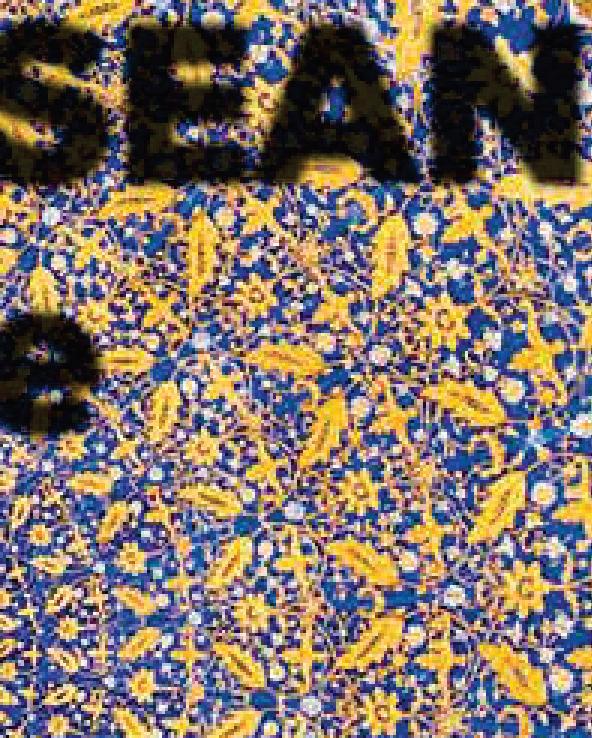



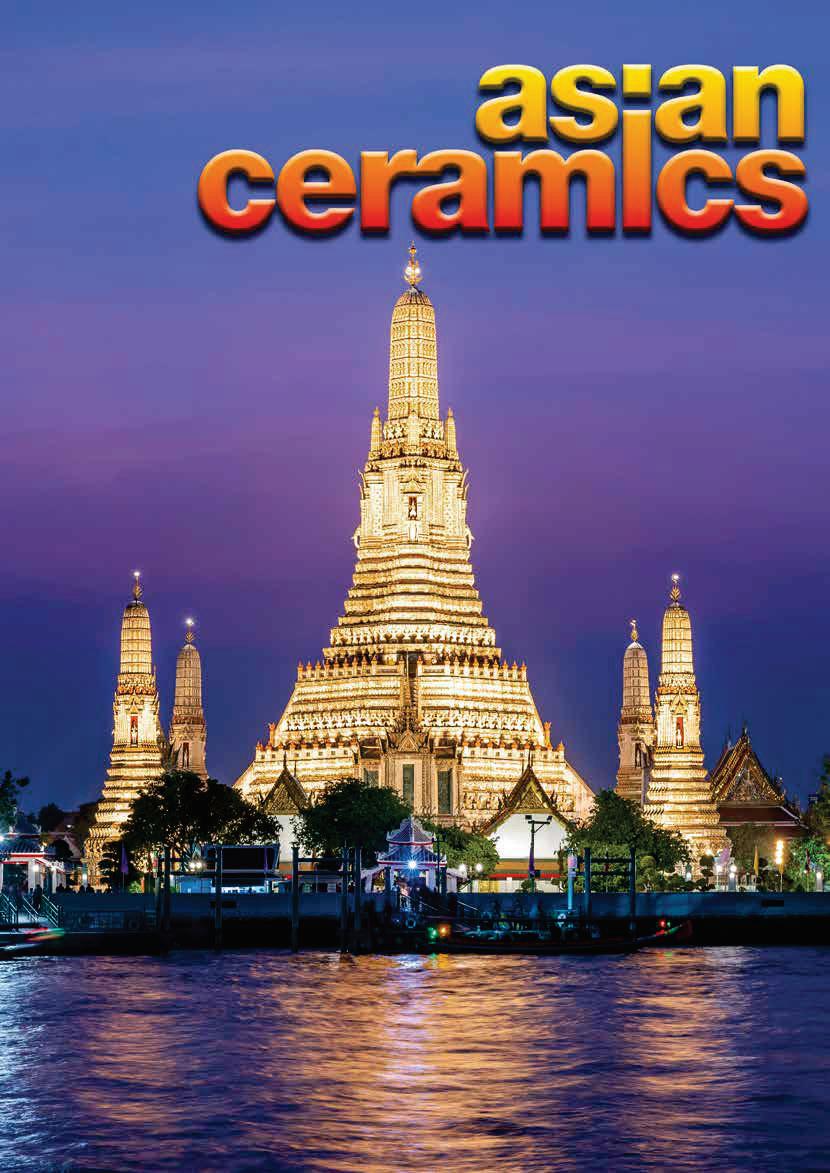































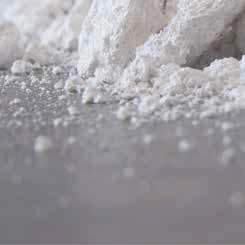


Theglobalceramicsindustryisundergoing a profound transformation – shaped by shifting consumer preferences, supply chain recalibrations, and increasingly intense regional competition. As we navigate this evolving landscape, the ASEAN sanitaryware market stands out as one of the most dynamic and fast-changing segments –where tradition meets innovation, and design sensibility converges with sustainability.






Our cover story, ‘Changing preferences for ASEAN sanitaryware’ by Jahir Ahmed, explores how Southeast Asia’s growing urban middle class is redefining what modern bathrooms should look and feel like. From Thailand to Vietnam, demand is no longer driven solely by affordability or durability – it is increasingly shaped by aesthetics, water efficiency, and smart design. Local manufacturers are innovating rapidly, while global players recalibrate their product portfolios and distribution networks to align with the new consumer mindset. The story demonstrates how ASEAN’s domestic brands are coming into their own – leveraging regional design identities and sustainability narratives to carve out market share against longestablished global competitors.



Yet, the shifts in ASEAN do not occur in isolation. They are intertwined with the broader dscape – where Thangadh and Morbi owerhouses. In our feature ‘Thangadh v Morbi: der Singh Malik examines the competitive h, steeped in tradition and renowned facturing prowess and export strength of lects India’s wider industrial evolution, where finding ways to coexist and complement
spar, the often-overlooked hero of ceramics. Gunasekera analyses how price volatility, gies are influencing production economics ance may fly under the radar, yet it is the quiet -efficiency of the products we admire and
aking its mark. In ‘Expanding lores how the country is leveraging create export opportunities. Once a w gaining international recognition for oning the country as a rising contender in
74 in Rapperswil-Jona, Switzerland, gy. In India, it operates as Geberit hyam, recently appointed managing Asian Ceramics about her experience ities shaping the company’s growth. Her calised to navigate India’s unique market
heme – the regionalisation of ceramics. o longer confined by borders. The with ASEAN, India and Bangladesh each

Editor Isaac Hamza
Email: ihamza@asianceramics.com
ADVERTISING AND DESIGN
Advertising Sales Paul Russell
Email: prussell@asianceramics.com
Direct line: + 44 (0) 787 621 2193
Valerie Adamson
Email: vadamson@asianceramics.com
Direct line: + 44 (0) 207 664 4574 Mobile: +44 (0) 7774 255 0514
Production and design Tim Mitchell www.corpsvector.co.uk
Bangladesh Jahir Ahmed jahir@asianglass.com
India
Yogender Singh Malik yogender@asianglass.com
Sri Lanka Rohan Gunasekera rohan@asianglass.com
Research Manager Andy Skillen
Email: askillen@bowheadmedia.com
HEAD OFFICE
27 Old Gloucester Street, London WC1N 3AX, UK.

Directors:
Valerie Adamson and Paul Russell.






Infinity Sky is the latest evolution in digital decoration by System Ceramics: the advanced printing solution designed to deliver maximum flexibility, outstanding print quality, and long-lasting performance


With a cutting-edge automated maintenance system and a modular configuration of up to 16 independent bars, Infinity Sky enables the creation of complex graphic effects, refined gradients, and sharp textures. The ink recirculation inversion system combined with ultrasonic activation ensures consistent operation, reduced waste, and extended component life.

Infinity Sky sets a new standard in ceramic decoration: a sustainable, fully customizable solution that reflects the technological excellence that has made System Ceramics a global leader in industrial innovation.

Visit systemceramics.com to discover more!


sanitaryware. Yogender Singh Malik examines how these rival
design trends reshape demand. Jahir Ahmed analyses how manufacturers and suppliers can capitalise on these shifting preferences.


sector is expanding its international footprint, with manufacturers steadily growing exports across key markets, writes Jahir Ahmed.
Gunasekera examines rising demand from ceramics and glass, and the growing pressure this places on global supply.
With a population nearing 70 million, Karnataka has become the largest consumer of ceramic tiles and sanitaryware in southern India, driven by urban growth, infrastructure expansion and rising real estate demand.


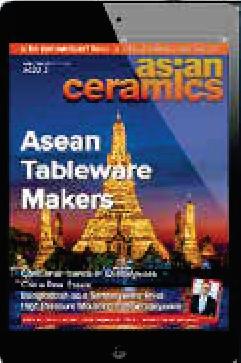






leadership,
Andy Skillen, special correspondent for Asian Ceramics, reports

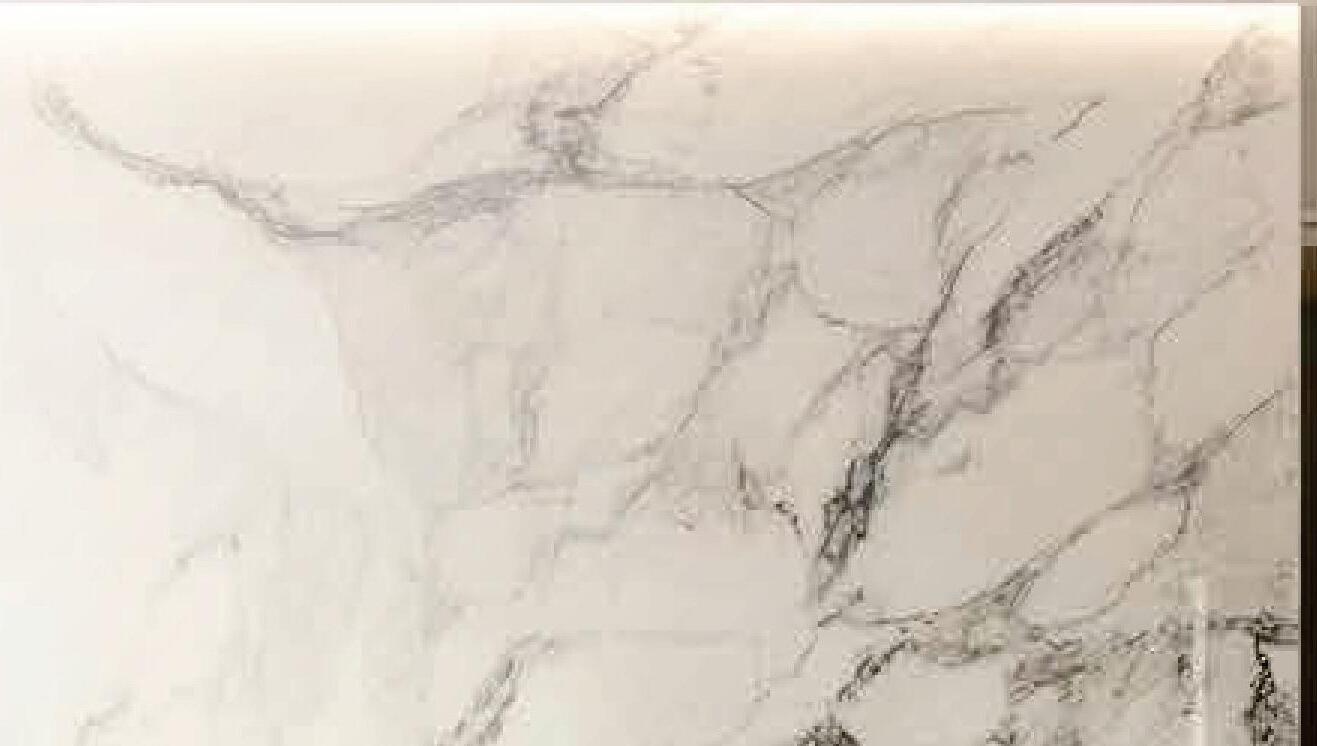



REFINED C L A Y

Please scan the QR code to explore our product range.

Our kaolin and clay products o er excellent plasticity, workability, and strength, making them ideal for a wide range of industries — from ceramics to paper production.
With high-purity minerals and top-tier performance features, our products enhance e ciency in manufacturing processes.



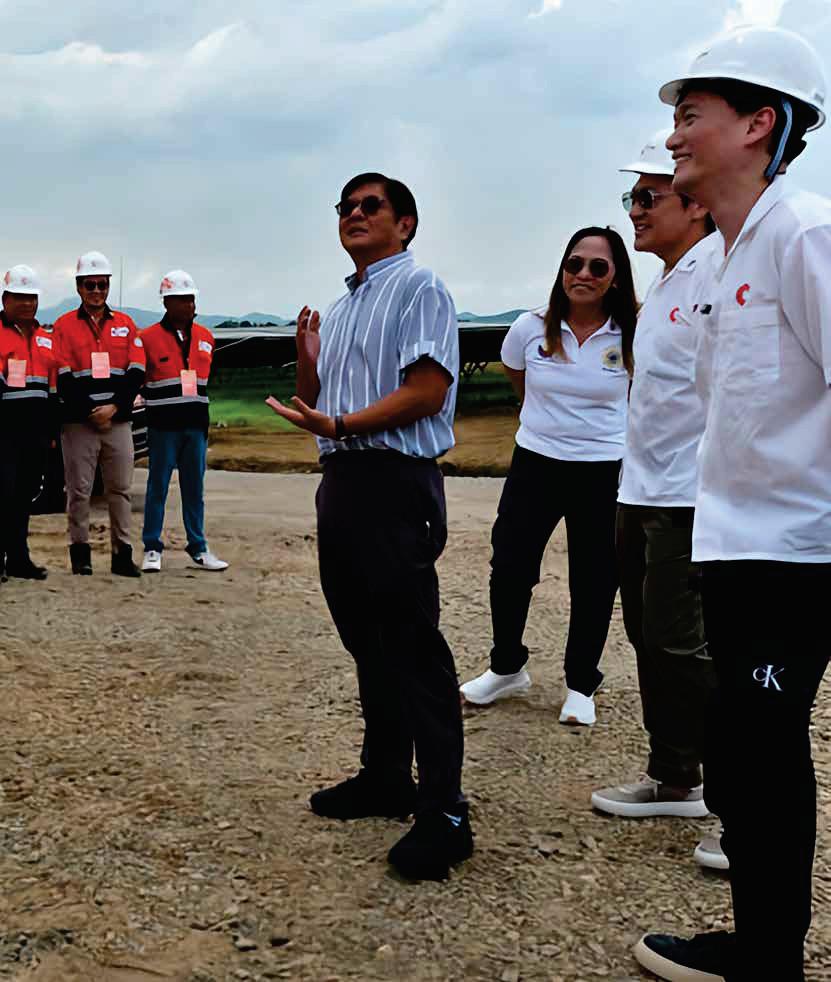
of Investments. creating additional income for farmers and promoting sustainable agricultural practices.

India’s ceramics industry has entered a defining moment. Long driven by the tile hub of Morbi in Gujarat, the sector has rapidly scaled into a global heavyweight. In 2025, India overtook several European competitors to become the world’s second-largest exporter of ceramic tiles, behind only China. This milestone reflects a powerful mix of manufacturing scale, entrepreneurial drive, and technological adoption. Yet as trade dynamics shift, Indian producers face mounting challenges that demand a recalibrated strategy to safeguard momentum.
Navigating new trade pressures
The most immediate disruption comes from across the Atlantic. In April 2025, the US Department of Commerce imposed countervailing duties on Indian ceramic tiles, arguing that exports were benefiting from state subsidies. This decision sharply increased the landed cost of Indian products in one of their most important overseas markets. Earlier in the year, the US had also introduced a blanket 25% tariff on Indian imports. For Gujarat’s ceramic manufacturers, the double blow of specific and general tariffs raises fears of lost market share. Spain, Italy, and Turkey – long-standing competitors with robust global distribution – stand ready to capitalise. If India’s foothold in the US weakens, the damage extends beyond revenue losses to brand perception and reliability in international trade circles. Morbi, contributing the lion’s share of India’s ceramic output, is particularly exposed. For local exporters, the challenge is no longer just price competition but navigating a shifting geopolitical trade environment where policy risk can upend business models overnight.
Diversifying markets, doubling down on innovation
The turbulence in the US underscores the urgency of diversifying export destinations. Encouragingly, India’s recent Free Trade Agreement with the UK offers a window of opportunity. Tariff relaxations and improved market access could enable UK-bound exports to expand significantly – potentially doubling
within the next four years. For Morbi’s manufacturers, this provides a buffer against US volatility and a platform to grow share in Europe. Yet geography alone is not enough. Competitiveness will increasingly hinge on innovation and value addition. Indian firms are already investing in precision kilns, digital glazing, and automated inspection systems. These upgrades improve efficiency and consistency while pushing product quality closer to European benchmarks. Highend buyers increasingly expect such standards as a given. Equally important is sustainability. Buyers are under pressure to cut carbon footprints, and Indian tiles must align with those expectations. Several Morbi producers are experimenting with energy-efficient kilns, closed-loop water systems, and eco-friendly raw materials. Firms that credibly demonstrate compliance with global environmental standards will not only differentiate themselves but also future-proof exports against tightening regulations.
Digital channels: a new trade frontier Another lever of resilience is digital transformation. Historically, tile exports relied heavily on exhibitions, showrooms, and in-person distributor networks. But post-pandemic shifts and digital adoption have changed buyer behaviour.
Virtual showrooms, 3D product configurators and online B2B marketplaces now allow manufacturers to connect directly with architects, contractors, and distributors worldwide. For India’s ceramic sector, this digital pivot reduces dependence on traditional trade fairs and accelerates entry into underpenetrated markets. Early adopters use digital platforms not just for sales but also to tell brand stories, showcase sustainability credentials, and highlight design innovations.
At the heart of India’s ceramic success is the ability to combine traditional craftsmanship with modern manufacturing. Morbi remains the anchor of this ecosystem, where generational know-how in design
and finishing merges with industrialscale production lines. This blend gives India the cost and design edge needed to capture markets across the Middle East, Africa, and now Europe. The question is whether this model can carry India forward in a world of trade uncertainty and sustainability scrutiny. Success will demand sharper positioning, stronger branding, and continued technology upgrades.
The path forward
India’s ceramic industry stands at a crossroads. The immediate challenge is cushioning the impact of US tariffs through market diversification and policy engagement. Simultaneously, the sector must invest for the long term – strengthening research and development, embedding sustainability, and scaling digital platforms. Resilience will not come from relying on historical strengths alone. It depends on how quickly and decisively exporters adapt to shifting global conditions. If the industry seizes this moment to rethink its approach, India can not only hold its position as the world’s second-largest tile exporter but also redefine its global role as a supplier of sustainable, innovative, high-quality ceramics. The stakes are high, but so is the opportunity. For Indian ceramics, the next phase of growth will be written not just in Morbi’s factories but in how boldly the sector responds to the demands of a new global trade era.

Baherden Ceramics sets up Turkmenistan sanitaryware plant • Eriez names Vietnam manager to boost APAC growth Technology and Rokid join hands promoting AR • Time Ceramics seeks approval for 292-M expansion in Batangas Materials acquires Ceramat • Chairman Bian Shares the "Breakthrough Code" for Going Global • Marjan announces
The Baherden Ceramics Sanitaryware plant has just been successfully started production in Turkmenistan, part of a megaproject tasked to SACMI to create a greenfield factory for the manufacture of ceramic tiles and sanitaryware.
The most modern factory in the country, created to substantially increase the national production share, the plant has recently been put into operation to start manufacturing, during this first phase, 200,000 pieces per year of high-quality design sanitaryware.
Already set up for future expansion, the plant was commissioned by Dowletli Dowran, a multi-business group operating in a variety of sectors from construction to the agri-food industry and built by the state-run ‘Eziz Doganlar Economic Society’. The inauguration ceremony was held in March last year in the presence of the highestranking government officials in Turkmenistan.
SACMI designed the entire plant according to the latest technological standards recognised in the sector. This is true from the body preparation department – already large enough to accommodate
future production expansion – to high-pressure casting technology with porous resin moulds, for which the customer chosetheSACMIALSmachine. The latter is renowned for manufacturing multi-mould items in vitreous china such as washbasins, pedestals, water tanks, oriental toilets and lids.
For the production of WC bowls during this first phase of the project a special department has been created to make plaster moulds using manual and mechanised casting with a BCV casting bench for double battery casting and servomechanised demoulding.
The decision to invest in modern technology, in line with the most advanced developments in the ceramic sanitaryware industry, has been the hallmark of the entire supply. Furthermore, with the help of the customer, SACMI has put together the entire technological know-how on all subjects ranging from the testing of bodies to modelling developments, subsequently perfected on site during the start-up stage. As regards the products, elegant shapes have been chosen, with a wide range of colours and modern design features.
Gadam Hoshvagtov, general manager of Dowletli Dowran, said: “With this project, we set ourselves two highly ambitious objectives. The first was to build one of the most modern factories in the country and, indeed,intheentirearea,ableto make a substantial contribution to national production in a sector where domestic market demand is growing rapidly.
“The second goal was to fix a market benchmark for product and process quality in line with thebestinternationalstandards. This is the reason we turned to SACMI, renowned throughout the globe for the quality of its technology and service.”
The plant also includes highefficiency SACMI dryers and RobotGlaze technology, with Gaiotto GA2000 robots. The two-position carousel supplied ensures perfect glazing quality, eliminating manual operations. The innovative solution leads the way also in terms of sustainability since it is equipped with the exclusive SACMI Mass Control system for controlling the flow rate and optimising the glaze trajectory.
The glazing booth is also equipped with dry filters for 100% glaze overspray recovery.
Automation and performance

are also the key features of the Riedhammer kiln, model HWS 15/500/140, with automatic handling, loading and unloading of 10 kiln cars, reaching a production output of 780 pieces per day (future production expansion has been considered here too).
Hoshvagtov said: “We are extremely satisfied by our partnership with SACMI not just thanks to their capacity to supply technologies and systems which are among the most advanced in the world, but above all because of their ability to manage every aspect of such an ambitious and complex project, the first of its kind to be carried out in our country.
“Fromtheinitialplanningstage right through to plant start-up, every step has been managed with skill, care, a cooperative spiritandinperfectsynergywith our technical teams, enabling us to fully reach the objectives we set.”
Eriezhas namedChien Dang Tranas country manager in Vietnam, reinforcing the company’s commitment to expanding across Southeast Asia while delivering more responsive support for local industries.
In this newly established position, Tran will shape Eriez’ strategy in Vietnam by cultivating lasting partnerships, uncovering emerging opportunities and
collaborating with regional representatives to provide separation technologies tailored to market needs.
Ezio Viti, regional sales director for Eriez Asia-Pacific, said: “This appointment represents another milestone for Eriez as we extend our reach across the Asia-Pacific (APAC) region.
“Chien’s customer-focused mindset and deep knowledge of Southeast Asian markets
make him uniquely equipped to accelerate our expansion in Vietnam.”
Viti added that “by placing experienced leaders in key markets, Eriez ensures that businesses benefit from localised expertise backed by the innovation, resources, and dependability of a global organisation.”
Established in 1942, Eriez is a global leader in separation
technologies. The commitment to innovation has positioned us as a driving market force in several key technology areas, including magnetic separation, flotation, metal detection and material handling equipment. The company’s more than 1,000 employees provide trusted technical solutions to the mining, food, recycling, packaging, aggregate, and other processing industries.
growth
•
STL, QNu Labs sign MoU to advance quantum communications • Lens Batangas • Roca Group acquires Australian company Phoenix • Lionstead Applied nounces RAK Central infrastructure completion...


STL,anadvancedconnectivity solutions company for digital infrastructure, has signed a Memorandum of Understanding (MoU) with QuNu Labs Pvt. Ltd. to strengthen research and development in quantum communications over optical fibre transmission.
Foundedin2016andincubated at the IIT Madras Research Park, QNu Labs is India’s first company to develop end-toend quantum cybersecurity solutions. Supported by the National Quantum Mission (Department of Science and Technology, Government of India), QNu aims to protect digital infrastructure from quantum threats and position India as a leader in quantumsecure communications.
India’s quantum communications market is projected to grow to USD 139.8 millionby2030,withacompound annual growth rate of around 34.6%. Under the National Quantum Mission, backed by
funding of approximately 6,000 crore, the country is aiming to build operational quantumsecure systems by 2031.
STL has been among the first companies globally to demonstrate field deployments of Multi-Core Fibre (MCF) technology, a key enabler for quantum communication. MCF usesSpaceDivisionMultiplexing in four- and seven-core configurations to deliver high transmission capacity within the same fibre diameter. The technology has already been deployed at the Department of Telecommunicationssponsored Advanced Optical Communications Test Bed at IIT Madras, meeting Essential Requirements under Telecom Engineering Centre standards.
As part of the collaboration, QNu Labs has demonstrated its Quantum Key Distribution (QKD) system over STL’s fourcore multi-core fibre (MCF). The demonstration achieved secure key exchange across 170
kilometres alongside 800 Gbps of classical data transmission, and over 150 kilometres with 1.8 Tbps of classical traffic. This represents a milestone in integrating quantum security with high-capacity optical networks.
Through this partnership, STL aims to accelerate research in quantum-secure communications by combining its optical fibre transmission capabilities with QNu Labs’ expertise in QKD, hybrid quantum cybersecurity and quantum cryptography. Both organisations plan to develop scalable architectures to support India’s participation in global quantum network development.
Sunil Gupta, CEO of QNu Labs, said: “We are not just protecting digital assets – we are working towards making India a quantum-safe nation and fortifying our digital sovereignty. Our partnership with STL will bring together their expertise in advanced optical fibre
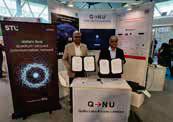
networks and our quantum security solutions, enabling the development of next-generation, secure communication infrastructure that can scale for India and beyond.”
Dr Badri Gomatam, CTO of STL, added: “STL has always pushedtheboundariesofwhat’s possible with optical fibre, and teaming up with QNu Labs adds a whole new dimension – STL’s global leadership in optical fibre transmission and QNu’s pioneering quantum security expertise. Together, we can build secure, future-ready networks that not only serve India’s needs but also set new benchmarks globally.”
The global augmented reality (AR) sector is entering a new phase of rapid growth, fueled by rising consumer demand and advances in optical waveguide technology. In China, AR device maker Rokid recently sold more than 10,000 pairs of its AR glasses in a single day, generating revenues exceeding RMB 30 million.
Supporting that milestone is Lens Technology, a Hunanbased precision manufacturing company that serves as Rokid’s exclusiveproductionpartnerand astrategicinvestor.Bycombining its manufacturing capacity with Rokid’s technological expertise, Lens Technology has
positioned itself as a central player in the industry’s transition from niche innovation to mass-market adoption.
The company contributes to Rokid’s success by delivering high-quality optical modules and providing comprehensive assembly services. According to the founder of the XR Research Institute, “The optical waveguide AR industry in 2025 has shifted its primary challenge from demand scarcity to production capacity constraints.” For Lens Technology, a global company in large-scale manufacturing, this shift plays directly to its strengths.
The partnership between
Rokid and Lens Technology has created what industry observers describe as a strong competitive edge: Rokid’s breakthroughs in optical waveguide design drive product innovation, while Lens Technology’s scalable infrastructure helps overcome production bottlenecks. With orders for optical waveguides projected to rise sharply in 2026, Lens Technology has indicated it will seek to optimise capacity utilisation and refine pricing strategies to capture growth.
As a strategic investor in Rokid, Lens Technology also stands to benefit financially from Rokid’s market expansion. Industry analysts suggest that
as AR glasses move from early adoption into the consumer electronics mainstream, Lens Technology’s expertise in precision manufacturing and scalable production will open up significant opportunities. Lookingforward,thecompany’s strategy of ‘independent innovation, scalable production, and ecosystem integration’ reflects its ambition to transform China’s AR supply chain from a follower into a global leader. With capacity constraints emerging as the defining challenge of the industry, Lens Technology’s role in enabling mass adoption of AR is expected to become increasingly significant.
Time Ceramics Philippines Inc. has applied for regulatory approval to expand its ceramic tile manufacturing facility in San Pascual, Batangas, with a planned investment of 292 million, according to media reports.
The proposed expansion aims to boost the plant’s production capacity from 49,000 to 450,000 metric tonnes per year, in response to growing demand from the residential, commercial, and industrial construction sectors. The company said the project would be implemented within the existing facility, as covered by its current environmental compliance certificate, and would not involve theconstructionofnewbuildings
or product lines.
According to Time Ceramics, consultations with stakeholders will be held to ensure transparency, gather feedback, and address potential concerns regarding environmental and community impacts. These discussions will form part of the company’seffortstocomplywith environmental regulations and secure the necessary approvals.
The manufacturer highlighted that the expansion would rely heavily on locally sourced raw materials such as clay, feldspar, and silica. This, it said, would promote the local supply chain while supporting the production of cost-effective and sustainable ceramic products.
Time Ceramics added that the
project is expected to generate employment opportunities, stimulate local business activity, and increase tax revenues for San Pascual and neighbouring municipalities. In line with its commitment to environmental stewardship, the company outlined several initiatives aimed at reducing ecological impact. These include the installation of advanced pollution control systems, the adoption of safer chemical alternatives, and the implementation of waste recycling programmes. Additionally, it plans to employ low-toxicity glazes, optimise the use of energy-efficient kilns, and introduce continuous emissions monitoring systems
to ensure compliance with environmental standards.
Time Ceramics underscored that the expansion aligns with bothcorporategrowthobjectives and national sustainability goals. The company said the project represents a balance between industrial advancement and environmental responsibility, contributing to the broader push for greener manufacturing practices in the Philippines. If approved, the expansion is expected to significantly enhance the firm’s production capacity and strengthen its role as a key player in the local ceramics industry, supporting the country’s construction and infrastructure development agenda.
RocaGroup,aglobalcompany in the design, production, and marketingofbathroomproducts, has acquired Phoenix, a tapware company in the mid-to-highend market segment, renowned for its design leadership and numerous international awards.
Phoenix is one of the leading tapware companies in the Australian market, where it designs, assembles, and markets bathroom and shower fittings. Founded in 1989, it has over 30 years of experience and offers a wide portfolio of products known for their highquality design.
The company, based in Melbourne and focused on design innovation, recorded a turnover of 35.4 million in 2024. Thecompanyhastwofacilitiesin Melbourne and one in Balcatta
(Perth). The main warehouse in Bayswater (Melbourne) was specifically designed to optimise the company’s logistics operations. Meanwhile, the Balcatta facility houses a showroom and a smaller warehouse, aimed at providing support and direct service to customers in the western region of the country.
Phoenix has established itself as a benchmark brand in the mid-to-high-end market segment thanks to its in-house design team, ranked number one in Australia and Oceania according to the international iF Design Award ranking. Its collections have received prestigious accolades, including the Red Dot Award and the Good Design Award, for their excellence in design, innovation,
and functionality.
With this acquisition, the group strengthens its position in Australia, where it is already present with its global brands Roca and Laufen. By the end of thisyear,itwillopenanewRoca Gallery in Sydney – bringing the total to eight worldwide – as well as a Laufen Space, where products from this brand will be showcased.
RocaCorporaciónEmpresarial is a Spanish, family-owned company headquartered in Barcelona, specialising in the design, manufacture and sale of bathroom-space products. It operates in over 170 countries, with 79 production plants in roughly 18-22 countries and employs around 20,000 people globally.
Originally founded in 1917 in

Gavà (Barcelona) as Compañía Roca Radiadores, the company began with cast-iron radiators, later adding boilers, cast-iron bathtubs (1929), sanitary porcelain (1936) and taps (1954).
Since 1999, Roca has pursued international expansion through acquisitions (notably Keramik Laufen in Switzerland) and by establishing production facilitiesabroad.In2005itexited the heating and air-conditioning business to focus entirely on the ‘bathroom space’.
LionsteadAppliedMaterials, the advanced materials platform of Lionstead Ventures (LV), acquired 100% of Ceramat Private Limited, a leading manufacturer of bioceramics and a subsidiary of Tata Steel Advanced Materials Ltd.
The acquisition strengthens LV’s advanced ceramics
portfolio and reflects our visiontoinvestintechnologies that will drive the next wave of industrial innovation in India.
Ceramat’s high-purity, biocompatible materials will address rising demand across orthopedics, oral care, pharmaceuticals, food, and cosmetics, where much of India’s needs are still met
through imports. Ceramat is positioned to deliver greater accessibility, lower costs, and stronger supply chain resilience for both domestic and global markets.
The opportunity ahead is immense. According to industry research bodies, the global advanced ceramics market, valued at $80 billion,
will reach $105 billion by 2030, while the bio-ceramics subset is expected to nearly double from $5.6 billion to $10.5–12 billion over the same period.
This is just the beginning. We are excited to help shape the future of advanced materials — from India to the world.

The second salon of the Guangdong Enterprises Future Forum, organised by the Guangdong Development and Reform Commission, was held at KEDA Industrial Group, bringing together leading business figures to discuss strategies for Chinese enterprises expanding globally.
Themed ‘New Heights, New Journey: Breaking Through and Accelerating Growth for Private Enterprises Going Global’, the event gathered over 30 entrepreneurs and executives from across Guangdong province. Attendees explored new ideas for globalisation, innovation, and resilience in the face of economic challenges.
During the forum, Peng Diao, director of the Private Economy Development Bureau of the Guangdong Development and Reform Commission, delivered opening remarks recognising KEDA Industrial Group
as a model of successful internationalisation within China’s manufacturing sector. He praised the company’s ability to adapt through changing market cycles and maintain a leading position in the global ceramics and building materials industry.
Under the leadership of Chairman Cheng Bian, KEDA has demonstrated the vision and adaptability needed to compete globally, noted Diao.
Bian was invited to deliver the keynote address, sharing insights from KEDA’s extensive experience in building a global presence. Drawing on lessons from the company’s building materials business, Bian outlined four key principles for success namely partner with strong, trustworthy collaborators; identify and develop untapped markets; empower and reward young talent; and maintain rigorous operational discipline.
Bian highlighted that despite the broader economic slowdown,KEDAhascontinued to perform strongly across its diverse business segments.
This resilience, he explained, has been driven by a strategic focus on export growth, talent development, and technological transformation.
KEDA’s ongoing investment in digitalisation, technology upgrades, and lean managementhasstrengthened its global competitiveness. The Group continues to prioritise efficiency, quality, and cost control, supporting steady growth even in challenging market conditions.
Bian also encouraged fellow entrepreneurs to remain thoughtful and patient amid uncertainty. “In times of change, slowing down to think deeply is essential,” he said. “Only by reflecting carefully can companies identify real opportunities and shape a
Marjan, the developer of freehold properties in Ras Al Khaimah, has announced the completion of infrastructure works at RAK Central, a mixeduse commercial development positioned as the emirate’s upcoming business hub. The company has also appointed Middle East Construction Group ALEC as the main contractor for the RAK Central HQ Office Complex, marking a significant milestone in the project’s progression.
RAK Central spans 3.1 million sq. ft. of prime land and offers 8.37 million sq. ft. of gross floor area. The completed infrastructure includes comprehensive wet and dry services such as stormwater, sewerage, firefighting, irrigation, potable water, electrical networks, and street lighting. Roads, cycle tracks, landscaping, and green spaces with hundreds of trees have also been delivered,
providing the foundation for vertical development.
With infrastructure now in place, sub-developers are set to commence commercial, residential, retail, and hospitality projects. The flagship RAK Central HQ Office Complex is scheduled for completion in Q1 2027.
Abdulla Al Abdouli, CEO, Marjan, said: “With the completion of infrastructure works and onboarding of global contractors, RAK Central has progressed into a new activation phase. The involvement of leading developers reinforces our vision to create a world-class hub that brings together business, lifestyle and tourism, enhancing Ras Al Khaimah’s reputation as a compelling destination for international investors and families alike.”
DesignedasRasAlKhaimah’s commercial nucleus, RAK Central offers Grade A offices,
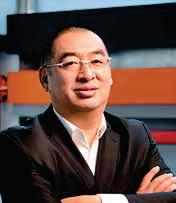
sustainable, successful future.” The Guangdong Enterprises Future Forum serves as a platform for sharing strategies and fostering cooperation among private enterprises. By hosting the second salon, KEDA Industrial Group reaffirmed its leadership role in promoting dialogue on global business development and innovation within China’s industrial sector.
residences, hotels, retail spaces, and a Town Square with premium amenities. The LEED Gold certified office buildings will feature dual licensing and investor-friendly frameworks, managed under a hospitality-driven model.
Located on Sheikh Mohammed bin Salem Al QasimiStreet,thedevelopment overlooks Al Hamra Golf Club andtheArabianGulf,withdirect access to the E-11 highway. The masterplan includes three million sq. ft. of rentable office space, more than 4,000 residential units, four hotels with over 1,000 keys, multiple parks, retail and entertainment facilities, and over 1,000 visitor parking spaces.
SinceitsJanuary2024launch, all plots within RAK Central have sold out, underlining investor demand.
Marjan, known for flagship projects such as Al Marjan Island, continues to drive Ras

Al Khaimah’s competitiveness in real estate, tourism, and investment, leveraging the emirate’s natural assets to deliver large-scale masterplanned communities.
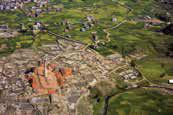
RAK Ceramics has signed a memorandum of understanding (MoU) with the Sheikh Saud bin Saqr Al Qasimi Foundation for Policy Research to support the training and employment of Emirati graduates.
The agreement was signed during the third Ras Al Khaimah Jobs and Internships Festival (RAKJIF), held at the RAK Exhibition Centre on 9th October. The event was organised by the Al Qasimi Foundation in partnership with the Department of Human Resources Ras Al Khaimah and the Investment and Development Office.
The MoU was signed by Rui da Silva, deputy director of the Al Qasimi Foundation, and Jasem Al Khateri, chief human resources officer at RAK Ceramics. It sets out plans for a structured programme of internships and graduate placements aimed at giving Emirati students and jobseekers practical experience in the manufacturing industry.
According to the Al Qasimi Foundation, the initiative is intended to link academic learning with on-the-job training and to improve the employability of local graduates. RAK Ceramics will provide internship and entrylevel opportunities within its operations, offering exposure to different departments and production areas.
The partnership forms part of ongoing efforts by both organisations to develop local talent in line with the UAE’s Emiratisation policies. No financial terms or specific targets for the programme were disclosed.
RAKJIF attracted more than 2,000 visitors, including students, graduates and jobseekers. Around 70 employers from sectors such as government, construction, banking, hospitality, energy, and manufacturing took

part. Exhibitors conducted interviews, recruitment drives, and career workshops throughout the one-day event.
The festival, first held in 2023, aims to connect Emirati jobseekers with employers across Ras Al Khaimah and the wider UAE. It is part of a broader strategy to support local employment and align skills development with the needs of regional industries.
A separate session titled AI and the Future of Work ran alongside the main exhibition. Speakers from academic institutions and private companies discussed how artificial intelligence is changing the workplace and whatskillswillberequiredinthe coming years. The discussions focused on adaptability, digital literacy and the integration of AI technologies into existing business functions.
Kerasys® LC Repair Solutions for Sanitary Ceramics

The Ras Al Khaimah Jobs and Internships Festival is expected to return in 2026 with continued participation from major employers and educational institutions. The organisers said future editions would maintain a focus on linking education, training, and workforce requirements in key sectorssuchasmanufacturing.


Kyocera Europe has announced a new collaboration with Switzerland’s iPrint Institute to accelerate research and development in industrial inkjet applications, including 3D printing, coating, and printed electronics. The partnership, beginning in October 2025, forms part of Kyocera’s wider strategy to expand its digital printing technologies into new industrial sectors.
The initiative will see Kyocera – known globally for its fine ceramic technologies and precision printhead manufacturing–workalongside iPrint, a public research institute within the School of Engineering and Architecture of Fribourg (HEIA Fribourg), part of the University of Applied Sciences and Arts Western Switzerland (HES-SO).
Digital printing technologies such as inkjet are increasingly recognisedascleanerandmore
flexible alternatives to traditional analogue processes. Unlike plate-based methods, they allow manufacturers to produce the required quantity directly from digital image data, while reducing environmental impact by eliminating liquid waste generatedduringplatecleaning. This shift from analogue to digital has accelerated in recent years, driven by growing demand for customised, small-lot production and ongoing automation in industrial environments.
Kyocera brings decades of experience in fine ceramics, fluid channel design, and manufacturing to the collaboration. Its proprietary ‘EX Series’ inkjet printheads currently hold the leading global market share in textile and commercial printing. Building on this foundation, the company aims to extend its technological expertise to new
industrial applications such as additive manufacturing and printed electronics.
Under the agreement, Kyocera will establish a dedicated research space within iPrint’s Fribourg facility. The institute’s advanced laboratories –equipped to handle a broad variety of inks and materials – will provide Kyocera with the environment to evaluate special inks and materials that have traditionally been difficult to process. The company will collect and analyse data from these evaluations to enhance and streamline its technical support capabilities.
Both partners have emphasised the environmental benefits of digital printing, particularly its potential to reduce waste and improve production efficiency. The collaboration aligns with Kyocera’s broader corporate goal of promoting sustainable
manufacturing through innovationandthedevelopment of more eco-efficient industrial processes.
By combining Kyocera’s expertise in ceramics and engineering with iPrint’s research infrastructure, the partnership aims to advance inkjet technology and strengthen its role in supporting next-generation industrial manufacturing.
iPrint conducts applied research in diverse applications such as graphic printing, electronics, and biomedical applications, and pursues R&D in state-of-the-art inkjet technology. With its interdisciplinary structure, iPrint connects people and knowledge, fostering innovation that supports the development of valuable products for the well-being of society and ecosystems in a sustainable manner.
Marking a major milestone in its four-decade journey, Ceramics China 2026 is set to open its 40th edition from 24th27th June next year at the China Import and Export Fair Complex in Guangzhou. Reflecting the Confucian notion of ‘Reaching Clarity at Forty’, the event moves forward with a renewed mission, steadfast identity and a clear vision for the future of the global ceramics industry.
Since its inception, Ceramics China has evolved into one of the world’s most influential platforms for technological exchange, trade cooperation and innovation in the ceramics andalliedsectors.Organisedby Unifair Exhibition Service Co., Ltd., the annual event continues to unite leading manufacturers, suppliers, and innovators under one roof—serving as both a driver and a mirror of the industry’s transformation.
The 2025 edition achieved unprecedented success, setting new benchmarks in participation and engagement. Compared to the previous
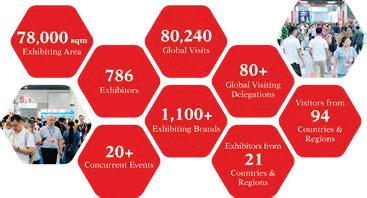
year, the show grew by 11% in exhibition space, 12% in exhibitor numbers, and 31% in visitor origin countries and regions.
Exhibitor satisfaction reached 93%, reflecting strong approval of the event’s scale, visitor quality and networking opportunities. Meanwhile, 92% of visitors rated the exhibition highly for its professionalism, comprehensive product range, and industry relevance.
The show floor featured a dynamic array of cuttingedge technologies, advanced
equipment, and innovative materials, addressing the evolving demands of a rapidly diversifying market. From automation and AI to green production and sustainable design,exhibitorsdemonstrated the sector’s readiness to embrace a smarter, cleaner, and more connected future.
Beyond the exhibition itself, Ceramics China 2025 hosted a series of concurrent forums and themed events focusing on digital transformation, AI integration, international cooperation, intellectual
property protection, marketing strategies, and environmental sustainability. These sessions provided actionable insights for businesses navigating the challenges of globalisation and industrial upgrading.
Over the past 40 years, Ceramics China has played a pivotal role in connecting global resources, fostering technological advancement, and accelerating industry modernisation. It has established itself not only as a showcase for innovation but also as a bridge linking global ceramic enterprises and markets.
As the industry looks to the future, Ceramics China 2026 promises to celebrate its 40th anniversary with a spirit of renewal and progress. With the theme “Forty with Clarity, Forward to Infinity,” the upcoming edition aims to pioneer a new era of integrated innovation, closer global collaboration, and sustainable growth for the ceramics and allied industries.










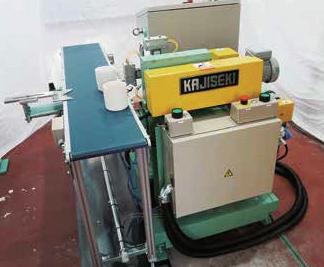











































































































KAJISEKI has built asystem capable of manufacturing tableware without the need for skilled engineers. Operation using an interactivedisplay not only allows you to manage the manufacturing process, but also gives you control over aspects of the production system such as production quantity and production errors.














































































































































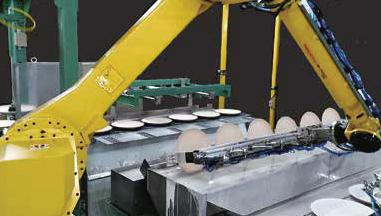
Head Office : 2-2-1 Hachiman-cho, Takahama, Aichi 444-1302, Japan
URL : http://www.takahama-ind.co.jp
E-mail : info@takahama-ind.co.jp
TEL : +81-566-52-5181
The Polish tableware manufacturer Lubiana hasrea rmeditstrustin SACMI-SAMAtechnology with a new investment in the DUO automatic dip glazing system. The move underlines the company’s commitment to maintaining flexibility and cra smanship quality, even within a highly automated and robotised productionenvironment.
Founded in 1969, Lubiana has established itself as one of Europe’s well-known producers of porcelain tableware, known for its advanced manufacturing systems and consistent product excellence. In recent years, the company has undergone significant modernisation, with majorinvestmentsinautomation, roboticsandenergye ciencyat its production site in Lubiana, nearKoscierzyna,Poland.
Among its technological highlightsarethePHO700SAMA presses,equippedwithautomatic robotised finishing units, demonstrating Lubiana’s drive towards full process integration.
Now,withtheadditionoftheDUO dip glazing unit, the company is extending this approach to its glazingoperations.
Designed by SAMA, the DUO systemprovidesanidealsolution for managing small production batches, prototypes, and complex shapes such as bowls, teapots and co ee pots. While loadingandunloadingoperations are performed manually, all glazing parameters are digitally managed through the control panel, ensuring precision, repeatability and high-quality surface finishes. These features makeDUOparticularlysuitedfor integrationalongsideautomated production lines, o ering maximum flexibility without compromisinge ciency.
The successful start-up of the new unit marks another step forward in Lubiana’s continuous improvement journey. Alongside the DUO investment, the company has recently inaugurated a new production hall featuring a SAMAisostaticpressinglinewith high-performance presses and

robotised forming and finishing units. Notably, the installation includes belt conveyors beneath the pressing stations to collect excess ceramic material directly from the process, minimisingwasteandsupporting sustainabilitygoals.
In addition, SAMA has implemented energy-saving upgrades to the presses, further reducing power consumption and contributing to Lubiana’s broader strategy for sustainable
industrialdevelopment.
The latest collaboration continues the partnership between SACMI-SAMA and Lubiana, reflecting shared objectivesininnovation,product quality, and environmental sustainability. Both companies plan to maintain joint e orts in automation and e ciency improvements, positioning their cooperationasareferencepoint for technological developments intheceramicssector.
BMW Group and E.ON have launched Germany’s first commercial Vehicle-toGrid (V2G) solution for privatecustomers,markingakey milestone in the integration of electricmobilitywiththenational energytransition.
The new service enables the BMW iX3 to become an active participantintheenergymarket, both consuming and feeding electricity back into the grid. For the first time in Germany, private electric vehicles can act as flexible energy storage units withineverydayuse.
The system is based on bidirectional charging, where the high-voltage battery of the BMW iX3 can return power to the grid via the BMW Wallbox Professional. Energy management is handled through E.ON’s digital platform and supported by a specially
developed V2G electricity tari that allows energy to flow in bothdirections.
The underlying so ware was co-developed by BMW and E.ON, designed for simplicity and transparency. Customers who make their vehicle battery available for smart charging and discharging can earn an annual bonus of up to €720. According to BMW, this could allow drivers totravelupto14,000kilometres ayearate ectivelynocharging cost, while contributing to grid stability and renewable energyintegration.
Marc Spieker, management board member of E.ON SE, Commercial, said: “What our customers need is a reliably charged vehicle, simple, convenient, and at attractive costs. That’s exactly what we provide,andmore.
“Together with BMW, E.ON is
bringingVehicle-to-Griddirectly to the people. Neue Klasse meets new energy. This is how we unlock the potential of the vehicle for each individual’s personalenergyfuture.
“We combine charging convenience with tangible economic benefits. And, as a bonus, every connected vehicle can help lower the overall costs of the energy system, for the benefitofall.”
Joachim Post, management board member of BMW AG, Development, said: “With the Neue Klasse, BMW makes the car an active part of the energy system, creating tangible customer value. Vehicle-to-Grid reducesthemobilitycostsofthe customer through new revenue opportunities while driving the futureofelectricmobility.”
Customers retain full control over their vehicle’s charging

goals, ensuring mobility needs are always met. Intelligent energy management protects batterylongevitybymaintaining optimalchargelevels.
The V2G technology will first be introduced with the BMW iX3, before expanding to other model ranges. In the long term, BMW and E.ON plan to integrate the service into a broader energy platform linking charging systems, photovoltaic installations, heat pumps and smart-home devices, forming the basis of an open and interoperableenergyecosystem.
UK ceramics firms fork out an estimated £875,000,000 a year in energy costs, Britain’s Labourconferenceheardon29th September,GMBUnionreported.
Thefigurehasshotupbymore than£330,000,000since2020.
Analysis by Nottingham Trent University suggests UK ceramics firms spend 70% of turnover on energy costs, and 14 per cent on Governmentandregulatorylevies.
Turnover of UK ceramics firms is around £1.25 billion, suggesting energy costs could be an enormous £875,000,000, with
leviesupto£150,000,000.
Analysisofhistoricenergyprices suggest in 2020 energy costs madeupjust55%ofturnoverfor UK ceramics firms – giving the figureof544,509,381.
Meanwhile the equivalent Chinese or US ceramics manufacturer, using the same amount of electricity, would be payingapproximatelythesameas what UK businesses were paying five years ago, and around 50% lessthantheydoatthemoment.
GMBwilltodaydemandgreater support for manufacturers and measurestolowerenergyprices
at the Labour Party conference inLiverpool.
Addressing the conference, Sharon Yates, a ceramics worker, who has worked at Dunoon in Stone,Sta ordshire,formorethan 30years,said:“I’maproudpottery worker.Justlikemydadbeforeme.
“The most highly skilled potters makeceramicsinmytown,andwe exportthemaroundtheglobe.But theindustrywerelyonisdying.
“Spiralling energy prices –especially gas – mean that UK ceramic firms fork out 875 million pounds in energy costs eachyear.
“That’s right – almost a billion pounds just on energy costs. All while counterfeit products from China have flooded the market, driving down demand for the goodswemake.
“The results are devastating. Thegovernmenthashelpedour industry with electricity costsbutwerelyongas.
“If we do not help industries like ceramics with energy costs now – and invest in their cleaner future – we will keep losing decent, unionised jobs. And when those jobs go, our communitiesgowiththem.”
Spanish ceramic manufacturer Venux has partneredwithGruppoB&T tomoderniseitsproduction line, aiming to address previous performanceissuesandincrease operational flexibility. The upgradeincludestheinstallation oftwoEVO8308pressesfromSiti, designedtoenhanceproduction speed, stability and consistency
while maintaining compatibility withVenux’sexistingequipment.
The EVO 8308 presses are reported to provide uniform compaction and faster, more stable production cycles. Gruppo B&T emphasised that the technology was fully tested and familiar to the customer, facilitating integration without operational

disruptions. The installation allows Venux to expand its product range, including new formats, and increase overall productioncapacity.
In addition to the presses, Venux continues to use the Dryfix digital printer from Projecta, a system capable of producing both decorative designs and high-discharge full
fields through the application of glue and grit. The technology supports detailed design work and enhanced aesthetic quality infinishedceramicproducts.
Gruppo B&T provided technical support throughout the installation and integration process, ensuring that the new equipment aligns with Venux’s productionrequirements.




Building materials giant Saint-Gobainhaslaunched a new five-year strategic plan, ‘Lead & Grow’, aimed at raising its growth and profitability targets while expandingitspositioninlightand sustainableconstruction.
The plan follows the success of the Group’s previous strategy, ‘Grow & Impact’, and will focus on outperformance through a broader suite of sustainable building solutions. Saint-Gobain, whichholdsnumber-onepositions in most of its markets, said it is targeting “mid-single-digit sales growth” in local currencies between 2026 and 2030, with an EBITDAmarginof15%to18%and aROCEabove13%.
ChairmanandCEOBenoitBazin said: “As the worldwide leader in lightandsustainableconstruction, Saint-Gobain is best positioned to address the key challenges of
the construction sector thanks to its full suite of innovative and sustainable solutions. With ‘Lead & Grow’, the Group further elevates its trajectory for growth, profitabilityandvaluecreationfor itsshareholdersandcustomers.”
Underthenewplan,thecompany intendstoinvestaround€12billion ingrowthcapitalexpenditureand acquisitions over the period, net of divestments. Asset rotation is expectedtorepresentmorethan 20%ofsalesby2030,withfurther portfolio optimisation to support valuecreation.
Saint-Gobain also plans to allocateapproximately€20billion in total capital between 2026 and 2030, maintaining a net debt-to-EBITDA ratio between 1.5x and 2.0x. Of this, about €8 billion is expected to be returned to shareholders – €6 billion via dividends and €2 billion through sharebuybacks.
The Group aims to boost its presence in high-growth regions such as North America, AsiaPacific and emerging countries, whichareforecasttoaccountfor around 60% of sales in the long term, compared to 50% today. It is also stepping up exposure to non-residentialandinfrastructure markets, including healthcare facilities, data centres, and transportprojects.
Bazin added: “Thanks to the know-how and commitment of ourteams,Iamconfidentwewill outperform in each geography and seize major opportunities: in Asia and high-growth countries driven by demographics and urbanisation, in North America with strong structural needs, and in Europe with significant potentialforrecovery.”
Saint-Gobain’s sustainable solutions now represent about 75%ofitssales,withitsproducts
CoorsTek, a global manufacturer of technical ceramics, has o ciallyopeneditsnew CoorsTek Academy Training Center, a state-of-the-art facility designed to train and upskill the next generation of advanced manufacturing workersinColorado.
Theribbon-cuttingceremony, held in July, brought together company leaders, state o cials, and education and industry partners to mark what CoorsTek described as a major step forward in workforcedevelopment.
Supported in part by the StateofColorado’sOpportunity Now grant, the new Academy will o er immersive, handson learning experiences for individuals pursuing careers in advanced manufacturing, a sector considered key to the state’s long-term economicgrowth.
Irma Lockridge, chief people and systems o cer at CoorsTek, said: “The opening of theCoorsTekAcademyTraining Center is the realisation of a
bold vision to shape the future of advanced manufacturing in Colorado. This facility reflects our commitment to developing talent,fosteringinnovation,and investinginthepeoplewhowill lead this industry forward. It's more than a training centre –it's a launchpad for meaningful careersandlong-termimpact.”
The Academy features modern manufacturing equipment to simulate realworldproductionenvironments. Training programmes will include apprenticeships in maintenance and tool and die, as well as certifications in CNC and advanced manufacturing, developed in partnership with local educational institutions. The curriculum has been tailored to reflect current and emergingindustryneeds.
Colorado Governor Jared Polis, who spoke at the ceremony, highlighted the role of initiatives like the CoorsTek Academy in addressing the state’sgrowingskillsgap.
“In Colorado, we are growing astrongworkforcetoday,tofill thejobsoftomorrow.Colorado’s
advanced manufacturing industry includes over 6,300 companies that employ over 150,000 workers. And as the industry continues to grow, so toowillthedemandforworkers with the skills needed to drive growth and innovation, helping students gain the necessary skills to succeed and fill indemandjobs.”
Founded in 1910, CoorsTek is a family-owned company headquartered in Golden, Colorado. It is recognised as a global leader in technical ceramics,supplyingengineered materials and components for industries including semiconductor, medical, automotive, and aerospace. The company operates with more than 400 proprietary ceramic formulations and advanced manufacturing systems,supportingcustomers worldwide in developing solutions to complex technicalchallenges.
With the launch of the CoorsTek Academy, the company aims to strengthen bothitsowntalentpipelineand
contributing to an estimated onebilliontonnesofavoidedCO emissions over their lifespan. The company has already reduced its own emissions by 34% since 2017 and is targeting a 40-45% cut by 2035, in line with its commitment to achieve net-zero carbon emissions by2050.
Foundedin1665,Saint-Gobain is a global leader in light and sustainable construction, designing, manufacturing and distributing materials and solutions that improve energy e ciency, comfort and performance in buildings and industry. Operating in 76 countries with around 160,000 employees, the Group reported more than €50 billion in sales in 2024. Its mission is to make the world a better home through innovation, sustainability and localvaluecreation.


















Asia’s largest kiln furniture manufacturer
Trusted supplier to major names
Reliable global partner
ISO accredited - validated systems
R&D customer support centre














Emil Muller, a wholly owned subsidiary of CeramTec, has unveiled a new brand identity under the name EMG – The Saltcore Experts, marking a strategic step in strengtheningitsglobalpresence andsharpeningitsmarketfocus.
The rebrand highlights EMG’s positionasaleadinginternational specialistinsaltcoretechnology, with an emphasis on innovation andadistinctidentitywithinthe CeramTecGroup.Thecompany’s new corporate design, modern logoandupdatedwebsiteaimto createaunifiedglobalimageand
reinforce trust and recognition amongitscustomersworldwide.
“For over 40 years, EMG has stood for the highest level of expertise in the production of saltcores,”thecompanysaidina statement. With manufacturing operations in Germany, Poland, Brazil, Mexico and India, EMG produces more than 20 million salt cores annually, supplying complex and customised applicationstoindustriesaround theworld.
While EMG has long been a key supplier to the automotive industry, the company is
now expanding its reach into sanitary technology, power tools and mechanical engineering. The broader focus reflects its ambition to diversifyapplicationsofsaltcore technology and respond to new marketdemands.
Chris Su , managing director of EMG, said: “With EMG – The Saltcore Experts, we are giving the long-standing expertise of EmilMullerGmbHaclearface.
“Thebrandhasanindependent international presence and is expanding its product portfolio in order to respond even better
totheneedsofourcustomers.”
The relaunch consolidates EMG’s decades of technical experience under a single, recognisable brand while maintaining its connection to parent company CeramTec GmbH, a global leader in advancedceramics.
By repositioning itself as EMG–TheSaltcoreExperts,the company aims to strengthen its identity as a dedicated partner for precision salt core solutions, combiningprovenexpertisewith a forward-looking approach to innovationandcustomerservice.
CeramicsUKmemberswere givenauniqueopportunity to discuss frontline issues in their businesses, and the wider sector, directly with parliamentarians at an exclusive event held at the House of Commonsrecently.
Representatives from across Ceramics UK’s membership, including clay brick, gi and tableware, refractories, advanced ceramics, suppliers and sanitaryware manufacturers took advantage of the trade association’s parliamentary dinner to engage with governmentrepresentatives.
HostedbyGarethSnellMPand sponsored by AMRICC, this was the second parliamentary event to take place in 2025, following the successful launch of the initiative by Ceramics UK earlier thisyear.
O ering meaningful exposure and direct engagement with key parliamentarians, each member had the opportunity to speak duringthecourseoftheevening to highlight the challenges and opportunitiestheyfaced.
Key issues raised included spiralling energy costs and the lack of a level playing field with internationalgoods.
Liam Byrne MP, Chair of the Business and Trade Select Committee,wastheguestspeaker and other parliamentarians in attendance included David Williams MP, Linsey Farnsworth MP, and Amanda Hack MP, who attended with members from
theirconstituencies.
Rob Flello, CEO, of Ceramics UK, said: “The evening o ered a unique opportunity for members to state really clearly the challenges that our industry faces,aswellastheopportunities.
“They set out the situation where government can step up and put in place the infrastructure, the support, the help, the guidance needed tothrive.
“With these measures in place, our UK ceramic sector can go from strength-to-strength, building a platform for national and international growth to enable this vital industry tothrive.”
Brynesaid:“Eventslikethisare absolutely critical in bringing frontlinerealitiesfromtheprivate sector, together with politicians who can make an impact here inParliament.
“We cannot get the legislation right without conversations like thoseheldhere.
“We've heard loud and clear some really strong messages fromindustryleaders.
“Energy costs are absolutely top of the list, but we've also heardabouttheneedtolevelthe playing field and address unfair competitionfromabroad.
“We also discussed the real opportunities for the industry to innovate, to grow and to contribute to our economic security and help us project that UK so power around the world forbrandsthatpeoplelove.”
Sebastian Lazell, CEO of the Denby Group, was one of the members at the event. He said: “There are always many messages to share, but at the heart of it, we're a 200-year-old brand and business that is a key part of the government's growth agenda, exporting ‘Made in England’productstocountriesall acrosstheworld.
“However, in these challenging economic times, we really need helpandsupportontheveryhigh cost of energy, both electricity and gas, so that there is a level playing field with competitors across the world who are better supportedandsubsidisedintheir ceramics and tableware industry bytheirgovernments.
“If we have a level playing field with that level of support, our goods will win day a er day, achievingmorecustomers,more business and more growth for Britain, but we need that help and we need it now because we havethemostexpensiveindustry energy costs anywhere in the worldandit'sreallyhurting.”
Earlier this year, Ceramics UK expressed disappointment that the multi-billion pound sector had not been acknowledged in the Government’s IndustrialStrategy,
Flello said: “The UK ceramics sector is a world-leader in the production of both traditional andadvancedceramicmaterials, supporting industries ranging from gi ware through to aerospace,defence,construction,

cleanenergyandelectronics.
“It contributes more than £2billiondirectlyto the UK economy annuallyanddirectly employs approximately20,000people as wellasenablingtensofthousands of other jobs from advanced manufacturing, through steel and glass workers, to bricklayers andmorebesides.
“We need to get the message acrossaboutitshugesignificance totheUKeconomyandthisevent in parliament o ered a unique opportunityformemberstostate really clearly the challenges that ourindustryfaces,aswellasthe opportunities."






























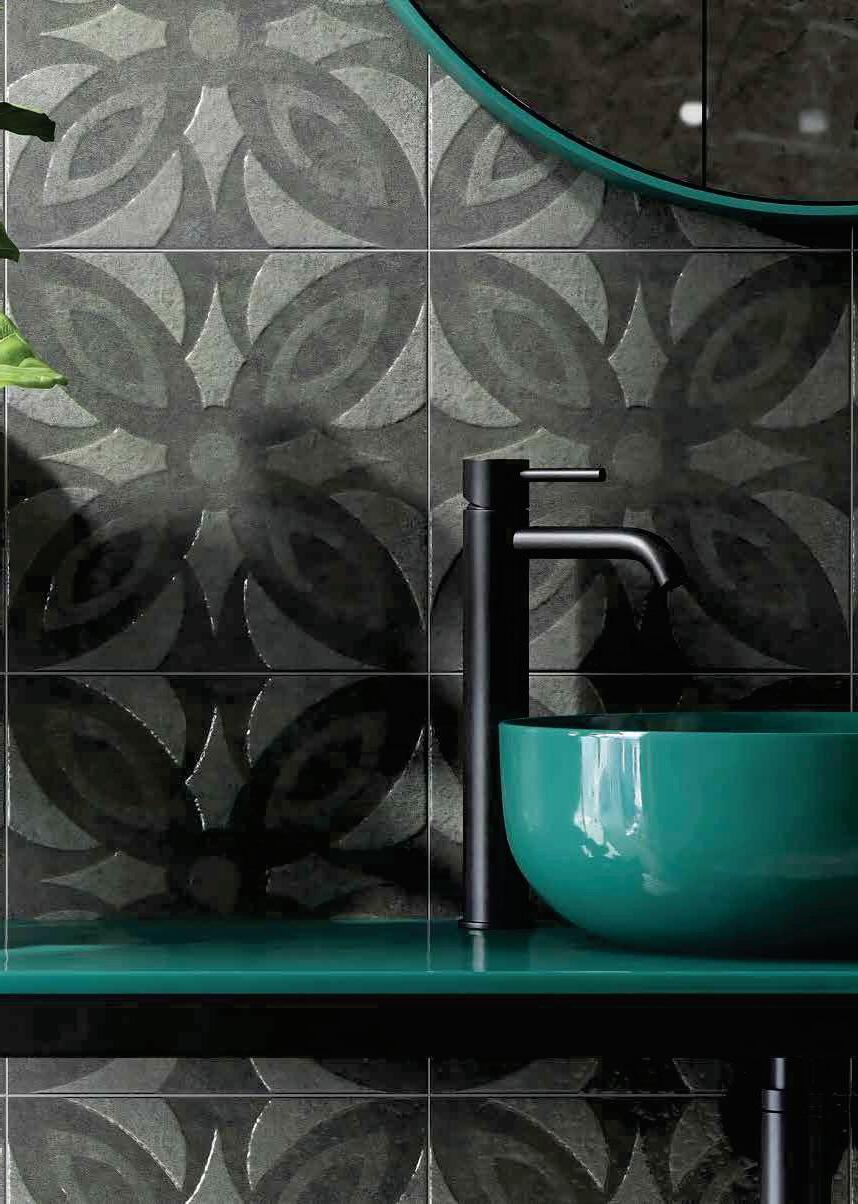

Airbus Ventures announced its investment in Fourier, emerging from stealth with its pioneering on-site, on-demand, hydrogen production systems, as part of the company’s $18.5 million in Series A funding. With this latest funding, the company will begin scaling manufacturing, accelerating commercial deployments, and expanding its engineering efforts to integrate its systems into critical energy infrastructure.

As the world’s energy demands skyrocket with the proliferation of artificial intelligence (AI) and advanced technologies, the need for energy solutions that are more reliable, secure, affordable, scalable, and cleaner continues to evolve. Hydrogen holds enormous potential to meet these demands, but high costs, inefficient production and complex distribution logistics have long stood in the way of its widespread adoption.
Al-Amir Aldan, co-founder, Fourier said: “At Fourier we are all about engineering audacity, bringing the brightest minds together to engineer solutions to biggest challenges that matter to us all. With rapidly growing demand for energy from AI and electrification, ensuring energy resilience is paramount (after all, energy is the foundation of human progress).
“For us, the first step is hydrogen. We are rethinking hydrogen delivery by making it on-site, on-demand and scalable. Our modular, software-defined approach does not just improve hydrogen production, it transforms it into a truly viable solution for energy resilience.”
Siva Yellamraju, co-founder and CEO, Fourier said: “We are just getting started. With this new capital, we are scaling fast, pushing boundaries and building a more energy-resilient world, where hydrogen plays a defining role.

“We are already seeing tremendous customer demand,
with early pilots yielding exceptional results across industries, like specialty chemicals, pharma manufacturing, metals and ceramics.”
At the core of Fourier’s technology is an ultramodular, software-defined system architecture that sets its hydrogen production apart from currently available systems. Their approach is driven by advanced algorithms that optimise performance in real-time, constantly adjusting to deliver the highest efficiency and reliability. Its architecture can monitor and predict performance, minimise downtime and ensure peak operational efficiency.
Airbus Ventures senior associate Abigail Hitchcock said: “Industrial decarbonisation will require revolutionary energy solutions. Fourier’s unique fusion of machine learning, modular electrolysis systems, and real-time optimisation is a powerful synthesis for structural advantage in scaling hydrogen where others have faced challenges.
“We believe this approach has the potential to reshape not just hydrogen production, but how we think about distributed energy systems more broadly.”
Fourier’s modular methodology reduces upfront costs, simplifies deployment, and ensures scalability as demand grows. By removing the logistical constraints of traditional hydrogen production, Fourier has helped forge a pathway for hydrogen to become a viable, cost-effective solution for industries like transportation, heating and cooling, and power storage.
Airbus Ventures operates in service of deeptech entrepreneurs who are inspired to design, build, and service complex engineering products capable of unlocking entirely new economies.
Fourier is a Palo Alto, California-based hydrogen production systems company.
QuantumScape Corporation, a developer of next-generation solid-state lithium-metal batteries, has signed an agreement with Corning Incorporated to jointly develop ceramic separator manufacturing capabilities. The collaboration aims to support high-volume production of ceramic separators for QuantumScape’s solid-state batteries, a critical step towards large-scale commercial applications.
The companies said the partnership combines QuantumScape’s expertise in battery technology with Corning’s long-standing strengths in ceramics and advanced materials manufacturing.
“QS and Corning are driven by a shared spirit of innovation in science and technology,” said Ron Verkleeren, senior vice president of Corning’s Emerging Innovations Group. “We’re excited to collaborate with QS to help advance the future of battery technology.”
Siva Sivaram, CEO and president of QuantumScape, described Corning as a natural fit for the company’s growing
ecosystem of partners.
“Corning’s world-class capabilities in ceramics manufacturing makes it an ideal addition to the QS technology ecosystem,” he said. “Together with our ecosystem partners, we’re building the foundation for scalable production of our high-performance solidstate batteries.”
QuantumScape’s solid-state lithium-metal technology is designed to deliver higher energy density, faster charging and improved safety compared with conventional lithiumion batteries, supporting the transition to a lower-carbon energy landscape.
Corning, a global leader in glass and ceramics with more than 170 years of innovation, brings extensive experience in glass science, ceramic science and optical physics across industries including automotive, semiconductors and energy storage.
The agreement represents a significant move toward industrialising solid-state battery technology, with ceramics at the centre of enabling large-scale energy storage solutions.
Researchers at the Federal Institute for Materials Research and Testing (BAM) have developed an innovative approach to make solid-state batteries more powerful and suitable for everyday use. Their goal: batteries that charge faster, last longer, and are more sustainable than conventional lithium-ion batteries. A new solid electrolyte could pave the way for a pioneering battery technology.
Conventional lithium-ion batteries have reached the limits of their performance: their anodes, which are usually made of graphite, can only store a limited amount of ions. Anodes made of pure lithium or the more sustainable and cheaper sodium offer an alternative – they could increase energy density by up to 40%. However, to operate safely, they require a solid electrolyte instead of a liquid one. A key problem here is that contact losses and voids can occur at the interface between the solid anode and the solid electrolyte, rendering the battery unusable. One possible solution is a partially liquid anode.

“However, this technology can currently only be used at 250 degrees Celsius. Our goal is to transfer its advantages to room temperature.”
To achieve this, the research team is experimenting with potassium additives that lower the melting point of the anode. The challenge here is that many common solid electrolytes are not stable enough when exposed to potassium.
The solution could lie in a special solid electrolyte based on sodium super ionic conductors (NASICON). These materials offer high ionic conductivity at room temperature and are chemically stable against potassium – especially when doped with hafnium. However, hafnium is rare and expensive.
In the NASICON project, Graeber and his interdisciplinary team of BAM experts are therefore looking for alternative additives that are just as effective but more sustainable and widely available. The most promising candidates are being tested directly in sodium batteries.
“In a study, we were able to show that a liquid alkali metal anode is a hundred times more powerful than conventional graphite anodes,” explains Gustav Graeber, battery material expert at Humboldt University in Berlin and guest researcher at BAM.
“Our research project is a decisive step toward highperformance batteries that are more sustainable, cheaper, and more efficient,” says Graeber. “Sodium solid-state batteries could drastically reduce charging times and significantly improve the performance of mobile and stationary energy storage systems— an important contribution to decarbonisation.”
Plug Power, a global comprehensive hydrogen solutions provider, announced in June a significant expansion of its partnership with Allied Green Ammonia (AGA), with a new twogigawatt (GW) electrolyser opportunity tied to a sustainable fuels project in Uzbekistan.
The deal will be executed during the Tashkent International Investment Forum, where Sanjay Shrestha, president of Plug, and Alfred Benedict, managing director of Allied Green, will be on site for the official signing.
Plug’s electrolyser technology has been selected as the foundation of a new $5.5 billion green chemical production facility in Uzbekistan that will produce sustainable aviation fuel, green urea, and green diesel. The project is backed by the Government of Uzbekistan and further strengthens Plug’s position as the preferred electrolyser provider for global-scale decarbonisation initiatives.
Andy Marsh, CEO of Plug, said: “This latest expansion with Allied Green demonstrates how Plug is leading the global hydrogen transition with proven electrolyser technology and execution at industrial scale.
“With a 5 GW partnership now spanning two continents, this is a defining example of our ability to deliver for customers building the future of energy.”
Benedict said: “This agreement reflects our deep confidence in Plug’s team, technology and ability to deliver on bold, world-class projects. Together, we are creating meaningful momentum for global decarbonisation, first in Australia, now in Uzbekistan, and in future regions to come.”
The Uzbekistan project builds on Allied Green’s previously announced three GW electrolyser commitment for its flagship green ammonia facility in Australia. The project remains on track for a final investment decision in the fourth quarter of 2025.
Shrestha said: “This continued collaboration with Allied Green reflects Plug’s ability to support ambitious decarbonisation goals with scalable electrolyser technology. As we look to expand our relationship, we see strong alignment in our shared vision for accelerating the global shift to low-carbon hydrogen across industries and regions.”
Plug’s technology is deployed or under development across five continents, supporting customers in the industrial, transportation, energy and chemical sectors. As global companies invest in green hydrogen infrastructure, Plug continues to stand out as the most experienced and scalable partner—delivering the integrated hydrogen ecosystem necessary to power the energy transition.

Boston-based Electrified Thermal Solutions, a company in electrified heating and thermal energy storage solutions, and HWI, a member of Calderys, one of the suppliers of refractory products and services in the US, recently announced a strategic manufacturing partnership. The collaboration will develop and produce electrically conductive firebricks (E-bricks) which will be used in Electrified Thermal's Joule Hive Thermal Battery.
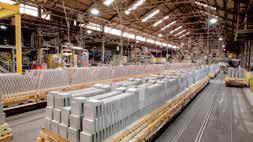
The Joule Hive Thermal Battery takes in electricity, then converts and stores it as heat through the E-bricks at temperatures up to 1,800°C (3,275°F), hot enough to power even the most demanding industrial processes. This capability allows customers to deliver consistent, high-temperature heat using renewable electricity at lower cost than traditional fossil fuels.
The E-bricks will be manufactured at HWI's production facilities, combining Electrified Thermal's technology, developed at MIT, with HWI's 160 years of refractory expertise. By leveraging this strategic collaboration, Electrified Thermal and HWI will demonstrate a viable pathway to reduce costs and mitigate emissions across energy-intensive industries. Electrified Thermal's first commercial-scale demonstration is expected to be operational in 2025, with the goal of deploying two gigawatts of electrified thermal power by 2030.
Daniel Stack, co-founder and CEO of Electrified Thermal Solutions, said: "Industrial heat represents one of the most challenging frontiers in the world's effort to address climate change. The majority of energy used annually for industrial heating worldwide comes from burning fossil fuels.
"To make a meaningful impact at global scale, we needed a solution that could be produced rapidly through existing supply chains. Our partnership with HWI transforms what could have been a manufacturing bottleneck into a powerful scaling advantage, allowing us to meet the multi-gigawatt demand we're
seeing from industrial customers worldwide."
Ben Stanton, director, Applications Technology for Thermal Markets, EEC and C/I Network, at HWI, said: "For generations, HWI has been developing advanced refractory solutions for the most demanding applications in industry. Electrified Thermal's E-Brick material is a breakthrough in refractory technology that maintains the high-temperature durability required by customers, while also generating the heat to run their processes.
“This partnership aligns perfectly with our Group's commitment to supporting our customers through their energy transition journey."
The industrial sectors increasingly seek viable pathways to reduce emissions while maintaining reliable performance, and this collaboration offers both benefits while providing opportunities to expand production throughput.
Bruno Touzo, global vice president of innovation and technology for Calderys Group, said: "Leveraging our extensive global network, deep expertise in refractory materials, and established supply chains, we are wellpositioned to support the design and rapid scale-up of E-brick manufacturing. This collaboration aligns closely with our broader innovation strategy and enables us to respond effectively to the growing demand from industries transitioning to cleaner energy solutions."
Electrified Thermal Solutions is pioneering the future of zerocarbon industrial heat. Developed at MIT, the electrically and thermally conductive bricks at the heart of Electrified Thermal's Joule Hive Thermal Battery (JHTB) represent a step-change improvement in electric heating technology in terms of hightemperature performance and durability. The company's JHTB generates, stores, and delivers unprecedented near-flame temperature heat (up to 1,800°C / 3,275°F), offering the most cost-effective, clean alternative to fossil fuels.
Egypt has discussed plans to develop a major industrial project focused on processing kaolin sand – a key raw material for the ceramics sector – as part of its wider strategy to expand domestic manufacturing and attract new investment into the minerals industry.
The initiative was discussed at a meeting chaired by Prime Minister Mostafa Madbouly at the government headquarters in the New Administrative Capital. The session was attended by Minister of Investment and Foreign Trade Hassan El-Khatib, Minister of Petroleum and Mineral Resources Karim Badawi, and INCOM Egypt Chairperson Hesham Sheta, alongside senior officials from both the public and private sectors.
The project, led by INCOM Egypt, will be based in the Suez Canal Economic Zone at Ain Sokhna. It represents a total investment of around 90 million and will focus on transforming Egypt’s extensive kaolin reserves into refined, high-value products used across industrial applications, including ceramics, paper and refractories.
According to government spokesperson Mohamed ElHomsany, the facility will incorporate advanced refining technologies that physically, chemically and thermally process kaolin to produce materials suitable for both domestic use and export. This approach is expected to reduce the country’s dependence on imported minerals while positioning Egypt as a competitive supplier in regional and international markets.
Minister Karim Badawi emphasised that the petroleum and mineral resources ministry is working to maximise the economic contribution of the country’s mineral wealth through downstream processing and localisation of industry. This, he noted, forms part of Egypt’s broader ambition to establish a diversified, industrialised economy that capitalises on its natural assets.
Prime Minister Madbouly reiterated that the government is committed to fostering investment and innovation across strategic industries – particularly mining and manufacturing – to drive sustainable growth and job creation.


Innovative new set-up for ALS casting cell already industrialised and launched onthemarket,withtworobotsworkingtogetherforhandlingandgreenfinishing operations.Workoutsidethecastingcellisreducedtoaminimumtomaintainhigh productionrates.
SACMI has made important progress in the field of handling/ finishing automation technologies for multi-mould casting cells, part of the range of high-pressure solutions offered by SACMI Robot Casting.
The main benefit of the latest innovation is the versatility achieved with a wide range of customisations possible – configurations and levels of automation can be tailored to suit customer needs – and, thanks to this advantage, SACMI has set a high benchmark in the sector, with the total number of machines installed reaching more than 700 units in 2024.
Among these, 125 are ALS machines for washbasins, followed by 36AVB, which are machines with the same structure but set up for moulds to produce 3-4-5 part WCs.
ALS:tailor-madeautomation
The key feature of the ALS casting plant is the wide variety of
configurations available, ranging from technology with manual demoulding to assisted demoulding with a zero-weight handling device, to help the operators move heavy articles.
Another possibility is robotised demoulding, which can incorporate different levels of automation as required, from demoulding alone, which, in any case, guarantees a high level of repeatability and precision, to full automation of all finishing and hardening processes.
New configuration with two robots. 90% fewer operations outsidethecastingcell.
The innovative configuration proposed, which has already been installed with great success at the factory of a top European manufacturer, is made up of two ALS casting machines for washbasins: two twin solutions, each of which can work with up to eight moulds to reach a total production output of 800 pieces per day (400 for each cell).
The special feature of this solution, the first of its kind on the market, is the automation set-up with two robots, one of which is positioned on a slide. They carry out automatic demoulding and finishing operations in sequence, after which the pieces are passed to the pre-drier and loaded onto the car.
During the first stage, the piece is removed from the mould and finished while green with multi-function tools (to make holes, sponging, fettling). This reduces by up to 90% the manual finishing operations required with a traditional set-up.
Pre-dryingandtransfertoautomatichandling(LGV)
At the end of the first sequence of operations, the second robot comes into action to transfer the piece to the FPV pre-drier, which helps the ageing process under controlled temperature and humidity conditions. The robot then removes the piece and positions it on the belt conveyor to be passed to the operator, who will carry out the minimal tasks left over, such as application of the code on the product and final sponging. Finally, the piece is loaded onto the LGV to be taken to the drier.
The 2+2 robots operate at the same time within the same working area, so all operations are synchronised. This allows both the cell and the robot to reach full production capacity, eliminating downtime. Even compared to the most advanced solutions already installed by SACMI, this configuration represents a further step forward in the robotised handling of these work stages, reducing work to be performed outside the cell to a minimum and sustaining the productivity of the line.
Automaticfinishing,robotisedhandling
Automation of finishing operations by means of a robot is one of the crucial requirements to improve the quality and repeatability of the ceramic sanitaryware production process, reducing manual operations to a minimum. SACMI has continuously invested in and has developed a variety of technologies over the years to offer a wide range of services to its customers, including both white finishing (SACMI Robot Clean) and green finishing solutions, with

more and more operations carried out directly on the piece leaving the casting cell.
Alongside integration with automatic handling (for demoulding, transfer to the pre-dryer, loading onto dryer cars, which is carried out more and more often by means of LGVs), the use of robots in the plant assists process control and systematic reproduction of all operations, reducing external variables that are a potential cause of errors, leading to an increase in rejects and inefficiencies.
Greaterversatilityevenforspecificaspectsoftheproduct Versatility remains a fundamental aspect, together with the quality and repeatability of operations. In the specific case of the ALS, one of the advantages of robotised green finishing is, among other benefits, the possibility to manage particular aspects of the product, such as making the overflow hole in washbasins, with even greater flexibility.
In fact, this can be done directly during casting by using a mobile insert placed in the mould, with a total guarantee of repeatability and quality. For some models, however, the customer may need to produce a series of pieces with the overflow hole and a series without.
With the finishing robot, the hole can be made downstream of the demoulding process, and there is the flexibility to choose whether or not to do this with the use of a suitable tool, which can be configured directly from the operator panel.




Together, Thangadh and Morbi account for nearly 70% of India’s sanitaryware output. Just 65 kilometres apart, the two clusters reflect contrasting legacies – Thangadh with over five decades of production history and Morbi as a newer but fast-growing challenger. Yogender Singh Malik explores how these rival hubs are shaping the future of India’s sanitaryware industry.
India is the world’s second largest sanitaryware manufacturer after China with an installed capacity of nearly 44 million pieces per year. About 75% of the total installed capacity and production of sanitaryware products occurs in the state of Gujarat. Most of this installed capacity is concentrated in ceramic clusters at Thangadh and Morbi.
Indian sanitaryware industry is divided into organised and unorganised segments. The organised sector includes established and large sanitaryware producers with higher product quality and higher production output from a single or multiple locations. Leading producers in the organised segment include Parryware Roca, Hindustan Sanitaryware Industries Limited, Jaguar, Cera Sanitaryware, Duravit, Kohler as well as the Japanese company Toto (Lixil). Collectively, these producers account for 16 million pieces of sanitaryware per year. Some of these organised sector producers, such as Duravit, Kohler, and Jaguar Sanitaryware, are based in Gujarat.
Sanitaryware cluster, Thangadh has about 220 sanitaryware producers with an installed capacity of 19 million pieces per annum. While the emerging sanitaryware production hub, Morbi, has an installed capacity of nine to 10 million pieces per annum through 90 sanitaryware producers.
The most important reason behind the emergence of sanitaryware
clusters in these two towns of Gujarat is the availability of clay (Than clay) in and around Thangadh and the easy availability of manual and skilled labour.
The Indian sanitaryware industry is expected to make steady progress in the foreseeable future on the back of robust growth in the country’s construction and real estate sectors. In 2024, the Indian real estate sector was valued at approximately $477 billion. It is projected to reach $1 trillion by 2030.
Thangadh's sanitaryware production
Located in the Surendranagar district of Gujarat, Thangadh is situated at 160 kilometres from Ahmedabad. The cluster is older than Morbi. Here, ceramic units primarily manufacture sanitaryware products. Termed India’s sanitaryware capital, the cluster is renowned for producing affordable sanitaryware products for the mass market. More than 220 small and mid-scale sanitaryware producing units are scattered around the town.
With a modern history of sanitaryware production of 55 years, the town is one of the two ceramic clusters in India. Spread over 350 km2, sanitaryware producing units in Thangadh can be classified into three categories, namely large (producing 1500 or more sanitaryware pieces a day), medium (600-1200 pieces per day) and small (less than 500 pieces).
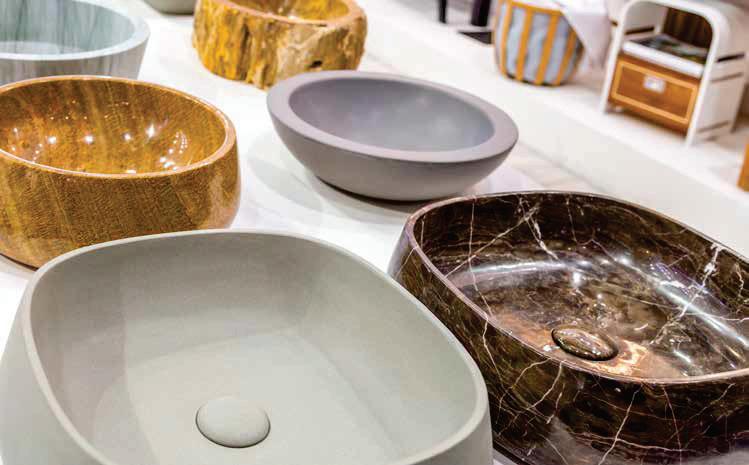
Currently there are 32 large, 46 medium and about 98 units on the small scale, producing sanitaryware for the domestic and export markets. Besides these, there are about 50 units, which do not have firing kilns, and are engaged in producing green pieces of sanitaryware for large and medium-sized players in the cluster, who later fire these products.
Besides, the main towns and villages near Thangadh, including Tarnetar, Jamawadi, Lakhamachi, Devadia, Aamraparve, Navagaon and Songarh have sanitaryware manufacturing plants.
About 15 large sanitaryware producing companies account for 40% of Thangadh's total sanitaryware production. Directly or indirectly, these larger companies own a number of smaller sanitaryware companies in the town.
Than Plasa Clay, which is abundantly available in an area spanning 100 km2 around Thangadh, is used by sanitaryware producers in Thangadh to produce sanitaryware products at jawdropping prices.
It was a common perception a few years ago that Thangadhbased producers could only produce basic products. Town-based units have, however, proven the sceptics wrong by increasingly producing high value-added products and designs.
In correspondence with Asian Ceramics, one of the leading sanitaryware producers based in Thangadh, Anchor Sanitaryware's CEO, Dushyant Sompura, stated: “The sanitaryware industry in Thangadh has seen steady growth in recent years. Government initiatives, such as Swach Bharat Mission, which drove the demand of low cost/economical sanitaryware products, has been one of the major factors behind the growth of the town’s sanitaryware industry.
“But this alone is not the demand driver of the sanitaryware industry in Thangadh. In the last few years, a number of units have increased their share of exports to some of the most demanding markets. While a decade back, almost 90% of the sanitaryware output in Thangadh was in the cheapest segment, the situation has changed in the last 10 years.”
Anchor operates two facilities that produce approximately
7,000 pieces per day. Founded in 1970 by Suresh Sompura, the company is currently managed by his son Dushyant Sompura. In the country, Anchor Sanitaryware is well known for its high-quality products. As well as these two plants, the company holds shares in six other sanitaryware production facilities in the state.
“Sanitaryware units in Thangadh are extremely cost-competitive. Quality of the products is accepted on all the major export markets. This is the reason why Thangadh-based sanitaryware producers have been able to increase their share of exports in recent years. Shunning traditional production practices and processes, producers here are embracing new technologies,” says Ashwin Maru, production and export manager at Sunrise Pottery Works, located in Thangad.
A significant improvement in energy efficiency and productivity has been noted in Thangadh's sanitaryware manufacturing facilities as a result of higher levels of automation and the use of the latest technologies in recent years. This has helped in improving product quality, reducing product losses, and reducing energy consumption, which reduced total manufacturing costs.
Known for its prowess in ceramic tile production, Morbi is emerging as a key sanitaryware production destination. There are currently 90 sanitaryware manufacturers producing premium and economy products for domestic and export markets.
In Morbi, sanitaryware production started in the second half of 2000s and gained momentum in 2010s. During the last four years, 16 new sanitaryware producers have joined the manufacturing domain in the Indian ceramic tile capital.
Leading ceramic tile producers, such as Kajaria Ceramics, Somany Ceramics and Simpolo Ceramics, have set up their sanitaryware production plants in Morbi in the last few years to take advantage of raw material availability, infrastructure and skilled labour.
Since Morbi is a large ceramic cluster, setting up a new sanitaryware plant takes lesser time than anywhere else in India due to the presence of many machinery and service suppliers as well as skilled contractors. For example, a large sanitaryware plant can be up and running in around six to eight months as compared to 12-14 months elsewhere in India.
Vishesh Detroja, production manager at Morbi-based Senisto Sanitaryware, says, “Mass scale sanitaryware production is relatively new in Morbi. However, Morbi-based sanitaryware producers have a number of advantages over sanitaryware producers in Thangadh. The primary advantage of Morbi is its access to key raw materials at most competitive prices due to a robust supply chain.
“Other factors such as the presence of most of the leading technology suppliers, spare parts suppliers, availability of natural gas, and availability of skilled manpower offer Morbi-based sanitaryware producers a number of advantages over their counterparts in Thangadh.”
Morbi has attracted several organised sector tile and sanitaryware producers to set up production units in recent years. Leading names in the Indian ceramic industry such as Kajaria Ceramics, Somany Ceramics, H&R Johnson, Orient Bell and Simpolo Ceramics have set up their sanitaryware production units to take advantage of a number of factors.
About a decade ago, Kajaria Ceramics, India’s largest ceramic tile producer, ventured into the production of sanitaryware. The company operates two sanitaryware production plants in Morbi. Kajaria Sanitaryware Pvt. Ltd. (KSPL), which began commercial production of sanitaryware production in 2014, has an installed capacity of 750,000 pieces per year. Kajaria’s other sanitaryware plant, Kerovit Global Pvt. Ltd. has a production capacity of 450,000 pieces per year. This plant commenced commercial production in March 2024. According to the company’s management, this plant is dedicated to producing premium and luxury products for discerning consumers in the domestic market.
Somany Ceramics, one of the most recognised names in the Indian ceramic industry, has also invested in a sanitaryware production plant in Morbi. According to Somany Ceramic’s management, “We began our journey in the sanitaryware segment in 2011 through our Morbi-based plant by offering comprehensive and classy washroom solutions. Each product in the range is crafted to cater for those who appreciate style and fine design. Designed to soothe and stimulate the urbane and sophisticated, the styles range from contemporary to neoclassical; some products are even crafted by leading designers from Italy. Our plant in Morbi is spread over an area of 88,000 square meters. We have one of the best equipped and largest plants for the production of one-piece toilets in a single premises in the ceramic hub, with an installed capacity of one million pieces annually.”
The majority of sanitaryware production in Thangadh (Morbi did not have many sanitaryware production units at that time) was based on the principle of the lowest cost production until a couple of decades ago, and many of these units succeeded by copying the products of organised sector’s brands and selling them under the Hindustan brand.
Sanitaryware products from most of these producers were considered low quality products fit for consumption in the mass markets in rural, semi-urban areas and low priority for government


construction. However, with the passage of time, some sanitaryware producers started to pay increased attention to the quality of finished products in order to cater to the urban and export markets.
During the initial years, the number of such producers was very less but gradually the count increased. With the gradual adoption of stateof-the-art technology, many units produce higher quality products.It has been observed that the number of new units producing more than 1000 pieces has steadily increased in recent years. The products produced by these larger units have improved significantly due to the usage of modern technology and quality control methods.
Outsourcing plays a key role in sanitaryware production in Thangadh and Morbi. Established sanitaryware producers outsource a part of their total output to sanitaryware producers based in Thangadh and Morbi. The trend, which started about 20 years ago, has gained significant traction over the past decade.
Most organised sector sanitaryware producers continue to outsource low and mid-end products while producing high and premium products in-house. The idea behind this strategy is that low-end products, which are technologically easy to manufacture are outsourced while technologically complex products are made in-house.
According to the CEO of a Thangadh-based sanitaryware manufacturer who spoke on the condition, “Outsourcing is a big business in Thangadh.
“Nearly 60% of the sanitaryware producers in the town outsource production in one or another form. A decade and a half ago, some sanitaryware producers used to produce a limited amount for other sanitaryware producers in the cluster when the former were idle.
“However, the trend of producing sanitaryware products for producers based elsewhere has gained huge traction in the last 10 years. There is no shortage of skills, technology, and capacity in Thangadh to produce basic and economy products. Larger sanitaryware producers have taken advantage of this strength of Thangadh-based producers and continue to outsource part of their production.”
Outsourcing has enabled organised sector producers to focus on their key models, adopt asset light approach, cost saving, and take advantage of their branding power. Furthermore, outsourcing allows organised sector producers to shift the focus from manufacturing to marketing.
Sanitaryware production in the Thangadh and Morbi clusters is experiencing a rapid shift towards premiumisation. There is a notable increase in the production of premium producst by a large number of sanitaryware production units in both the clusters. The number of such units is higher in Morbi as compared to Thangadh.
Indian sanitaryware industry has registered steady growth due to increasing demand in the domestic market, which is growing rapidly due to urbanisation, rising disposable incomes, vast infrastructure projects, and government initiatives such as the Pradhan Mantri Awas Yojana, and development of Smart Cities.
Over the past many years, Thangadh and Morbi, the two torchbearers of the Indian sanitaryware manufacturing industry, have been at the forefront of the Indian sanitaryware manufacturing.
While Thangadh is the older of the two and more competitive in low cost and economy models, Morbi-based sanitaryware
Leading sanitaryware producers in Thangadh Company Installed capacity (on per annum basis)
A One House
Pottery
Mangaldeep Ceramics
Marvel Ceramics
New light Ceramics
Paragon Ceramics
Raghuvir Ceramics
Rainbow Ceramics
Saffron Sanitary ware Company
Silver Ceramics
Smruti Ceramic Industry
Sunstar Ceramics
Uday Ceramics
V B Naryana & Company
pieces
pieces
pieces
pieces
pieces
pieces
pieces
pieces
pieces
pieces
pieces
pieces
pieces
producers manufacture economy and premium models at a slightly higher manufacturing cost.
It is expected that both the sanitaryware clusters – Thangadh and Morbi – will play a central role in meeting domestic and export demands in the foreseeable future. Thangadh-based producers are increasingly embracing automation and state-of-the-art technology for domestic and European technology suppliers. There will be an opportunity for a number of producers to move up to the premium and upper economy models as a result. There are a selected few producers who are already included in this category, but the number is very small.
Morbi-based sanitaryware producers have gained significant market share over the past 10 years in upper economy, premium, and in some cases luxury markets. About a dozen producers in Morbi work as outsourcing partners of organised sector producers. This trend is expected to gain momentum in coming years.
As the CEO of a leading Morbi-based sanitaryware producer noted under the condition of anonymity, “Almost all the organised sector producers are sourcing a part of their total production from Morbi-based sanitaryware producers. In the future, we expect about 30-35% of the total output of these organised sector producers to be produced in Morbi.”
Most of the sanitaryware producers in Morbi are subsidiaries or sister companies of tile producers based in the town. Tile producers with large distribution networks, warehouses in different cities and exclusive showrooms ventured into sanitaryware production to take advantage of these infrastructure facilities as the consumers for both the product segments are the same.
With rising domestic demand, increasing exports, and a growing focus on innovation, design differentiation, and sustainability, both Thangadh and Morbi clusters are wellpositioned to navigate short-term pressures and emerge stronger. Producers who invest in technology, quality, and brand building are likely to protect margins and capitalise on long-term growth opportunities, ensuring the clusters remain key drivers of India’s sanitaryware industry.
Leading sanitaryware producers in Morbi Company Location
Midas sanitaryware Sartanpar, Morbi
Kajaria sanitaryware Morbi
Solitaire Sanitaryware Limited National Highway, Morbi
Solexo Ceramics LLP Wankaner
Polo Sanitarywares Rangpar, Morbi
Aqutop Ceramics Wankaner Highway, Morbi
Osho Sanitaryware Pvt Ltd Makansar, Morbi
Senisto Sanitaryware LLP Halwad Road, Morbi
Nobel Industries Old Ghuntu Road, Morbi
Costar Bathware LLP Ghunto, Morbi
Euroca Industries Jambudiya, Morbi
Cozy sanitaryware LLP Juna Sadulka, Morbi
Sona Ceramic Old Ghuntu Road, Morbi
Lalpur Potteries National Highway, Morbi
Sifon Ceramic Morbi
Itaca Sanitaryware Rangpar, Morbi
Silora Sanitaryware Morbi-Halwad Road, Morbi
Varmora Sanitaryware Wankaner, Morbi
Belmonte Lalpur, Morbi


From water-saving fixtures to contemporary aesthetics, ASEAN’s sanitaryware market is witnessing a transformation. For suppliers and manufacturers, these shi ing preferences present both challenges and opportunities for growth, says Jahir Ahmed.
Consumer preferences for sanitaryware are shifting toward smart features, ecofriendliness, high-tech hygiene, and water conservation across the 10 member countries of the Association of South East Asian Nations (ASEAN). Rising disposable incomes and urbanisation is accelerating the demand for smart and advanced sanitaryware, including bathroom fixtures. Increasingly, consumers are seeking bathroom equipment with automated and technological features for greater convenience and comfort.
Sources with the industry indicate that the increase in awareness of health and hygiene, especially since the COVID-19 pandemic, is driving demand for products such as rimless toilets and touchless faucets in the ASEAN countries, especially in the ASEAN countries that manufacture sanitaryware, such as Indonesia, Malaysia, the Philippines, Thailand and Vietnam.
The ASEAN market is also seeing increasing demand for
cost-effective products from Chinese manufacturers. However, such demand has posed a threat to regional sanitaryware manufacturers, according to the Ceramic Industry Club of ASEAN (CICA).
Under pressure from Indonesia ceramic manufacturers, the Indonesian government introduced an anti-dumping duty (BMAD) on cheaper imports from China when the capacity utilisation of the country’s sanitaryware factories fell to 54.3% (tableware 47% and tiles 62%).
“We are not against imports, but we oppose unfair trade practices, dumping, and predatory pricing," says Edy Suyanto, chairman of the Indonesian Ceramic Industry Association (ASAKI), and also chairman of the Indonesian chapter of CICA.
As consumers increasingly favour eco-friendly and sustainable solutions, including water-saving technologies found in modern toilets, they are also beginning to prioritise the aesthetics and visual design of sanitaryware, seeking products that complement their overall bathroom decor.




Industry sources say that, inspired by Japanese and Western innovations, demand is increasing for smart toilets with integrated bidet functions, including multiple spray options, remote controls, heated seats, and self-cleaning nozzles. Local manufacturers and international brands compete on the market, with international players often collaborating with local manufacturers to expand their reach.
The market for Thailand, ASEAN’s major manufacturing hub for global sanitaryware companies, is highly influenced by both local tastes and export demand, including innovative products like Toto’s Washlet. Other ASEAN markets are also rising, driven by urbanisation and living standards. ASEAN consumers adopt advanced, functional and affordable sanitaryware.
Thailand’s residential and commercial sectors are implementing smart systems that emphasise hygiene, water efficiency, and convenience. Cost and innovation balance influence consumer preferences and market growth.
SCG, Thailand’s largest ceramic sanitaryware manufacturer, offers a wide range of products, including toilets, bidets, washbasins, urinals, bathtubs, squats, and cabinets, under well-known brands, which meet the needs of all groups of customers in the domestic and export markets. Local product brands include Cotto and Sosuco, which primarily serve the Thai market. SCG’s other product brands are Prime for the Vietnam market, Mariwasa and Campana for the Philippines, and KIA for Indonesia.
There is a growing trend among customers towards smart and echo-friendly toilets. To respond to that, SCG effectively meets the needs of key target customer groups while also promoting and driving sales of high-value-added products. This is achieved by introducing new products that align with the specific needs of various customer segments, such as wellness-oriented product lines.
The SCG smart series of water-saving sanitaryware features water usage rates lower than the industry standard of six-litres per flush. Smart automatic toilet model C10207 VERZO utilises only 3.8 litres per flush, superior to the industry standard by 36%
The smart touchless toilet model C105287 Riviera Pro uses 4.8 litres per flush, superior to the industry standard by 20%. It features a touchless system for convenience and hygiene. It is also coated with Ultra Clean+, which can reduce bacterial accumulation by up to 99% within 24 hours.
In Vietnam, Viglacera Corporation, Caesar, Kohler, Toto, Lixil, and American Standard promote energy and water-saving products, including sensor faucets with high efficiency, to appeal to ecoconscious consumers.Government initiatives to improve public sanitation and infrastructure support have accelerated the growth of the sanitaryware market with advanced sanitaryware products.
State-run Viglacera maintains a significant market share, shifting toward consumer preferences for smart features in domestic markets. International brands, such as Toto, Kohler, Lixil, and American Standard, are gaining traction, particularly in the premium segment.

Vietnamese consumers are moving away from basic, functional products and prioritising modern, smart, and space-efficient fixtures that offer a more luxurious and convenient lifestyle in space, especially in apartments.Their increasing disposable income and the adoption of smart home technologies make tech-integrated bathroom products and smart toilets with touchless features highly desirable for the urban middle class.
Urban consumers prefer smart toilets with features like automatic flushing, heated seats, antibacterial coatings, bidet functions, and sensor-based operations, which are gaining traction. Driven by the latest lifestyles and heightened hygiene awareness, especially in the post-pandemic period, contactless faucets and sensors are becoming more popular.
Viglacera is actively competing with international brands by investing in advanced technology, such as Nano-fired enamel for stain resistance and water-saving features. In Vietnam, concealed sanitaryware, such as wall-hung toilets, is also gaining popularity to create a more compact and spacious bathroom environment.
The Vietnam Building Ceramic Association (VIBCA) has indicated that the Vietnamese sanitaryware market is undergoing a significant shift, driven by rising disposable incomes, urbanisation, and a growing consumer preference for modern, smart, and sustainable products.
Vietnam’s growing environmental awareness is driving a preference for eco-friendly and water-saving sanitaryware, according to Vu Quoc Hung, Secretary General of VIBCA. Manufacturers are responding by focusing on features like lowflow faucets and dual-flush toilets to conserve water and align with green building standards.
Viglacera says, to cope with consumer preferences, it has launched its newly developed holistic bathroom solutionwith a strong technological edge. These innovative solutions are designed with three priorities in mind: protecting user health, minimising environmental impact and enhancing quality of life.
Industry sources reveal key technologies including 99.9% antibacterial glazed ceramic sanitaryware surfaces treated with nano-glazing that eliminates harmful bacteria and ensures optimal hygiene. Thisgreen building material ecosystemis integrated into the bathroom space.
Its features include water-saving flush technology, which reduces water consumption by at least 20%, supporting efficient resource use. Smart sanitaryware devices are equipped with features like motion sensors, automatic lids, intelligent flushing, deodorizing systems, and heated seats for a modern, urban lifestyle.
In Vietnam, smart sanitaryware consumption is primarily driven by the steady expansion in the country’s GDP, changing consumer lifestyles, along with a growing preference for modern, stylish and functional bathroom spaces. Increasing urbanisation, infrastructure


development, and greater awareness of hygiene standards are contributing to the market expansion across both residential and commercial sectors in the country.
Indonesian sanitaryware manufacturers have to meet changing preferences of the country's consumers. Foreign operators, PT Surya Toto Indonesia, PT Roca Indonesia, PT Kohler Indonesia, PT American Standard Indonesia, PT INAX Indonesia, and several local manufacturers, now manufacture various types of smart toilets and other sanitaryware for domestic and export markets.
Market analysis indicates that the leading player, Toto Indonesia's sanitaryware consumers are shifting their preferences toward technology-integrated, sustainable, and high-design products, driven by Indonesia's growing middle class, rising urbanisation, and an increased desire for home-spa experiences.
Products like Toto’s Washlet offer a heated seat, warm water for cleansing, and automated functions, all controlled by a remote. Its popularity demonstrates a preference for a more hygienic and comfortable bathroom experience. Automatic faucets, flush mechanisms, and sensors are becoming more commonplace, particularly in high-end homes and commercial spaces.
Indonesian consumers in urban areas increasingly favour smart toilets and other intelligent fixtures with features like automatic flushing, touchless faucets, and integrated bidets for enhanced comfort and hygiene. Toto Indonesia plays a significant role in providing smart toilets. Its products include the company's signature Washlet bidet toilet seat, which leverages air-rich water droplets for a more comfortable and hygienic cleanse.
Cities are developing new homes and apartments that require modern amenities, driving the ceramic sanitaryware market. This trend underscores urban development’s essential role in shaping

30 largest importing markets for sanitaryware exported by the Association of South-East Asian Nations (ASEAN), under HS code 6910 Unit: US Dollar thousand
ImportersExported value in 2020 Exported value in 2021 Exported value in 2022 Exported value in 2023 Exported value in 2024
United States of America 103,484161,679106,939104,706136,815
Japan 98,23984,54195,22890,995102,229
China 69,59485,56859,42448,54333,518
Taipei, Chinese 23,96926,66129,37628,36832,475
Australia 13,12012,27614,25510,54913,746
Singapore 4,4316,9787,8137,68612,316
Philippines 6,89911,56817,58415,82711,887
Germany 12,56316,92215,2195,94911,311
Cambodia 17,44417,75017,80712,84910,054
Myanmar 13,95311,96313,99511,5799,653
India 2,2103,5424,5144,5506,318
South Korea 6,9018,2086,5784,9486,014
Hong Kong, China 6,0398,9806,8495,2455,385
Malaysia 3,9634,7634,6555,6915,312
Laos 5,4805,6705,2315,1994,698
Thailand 3,2813,5753,8674,2594,672
Indonesia 3,0024,3043,3753,3084,214
Saudi Arabia 2,5522,1824,6206,6423,520
Vietnam 3,5523,2297,4894,7733,295
United Arab Emirates 1,7381,7421,5741,6483,209
Sweden 2,8883,9091,4514141,800
New Zealand 2,6683,3174,0751,9111,482
Bangladesh 1,0531,5351,6411,5861,124
Russian Federation 9741,1607241,464966
Netherlands 4935274371,010774
United Kingdom 9018298271,132772
Qatar 1,2522,1501,093497757
Norway 739228518580671
Canada 1,1522,7291,168167559
Maldives 326401745443538
Source: International Trade Centre (ITC), Geneva.
Indonesia's housing landscape. According to market analyst Stellar Market Research, the shifting consumer preferences in Indonesia favour modern, stylish and functional bathroom fixtures, opening avenues for manufacturers.
Indonesia's increasing focus on hygiene and sustainability drives demand for high-quality, easy-to-clean ceramic sanitaryware. Government initiatives help promote sustainable development and encourage the adoption of eco-friendly options in the sanitaryware markets. This emphasis on cleanliness and environmental responsibility shapes consumer choices in the sanitaryware sector.
Consumers are provided with innovative products. Currently, there is rising demand for sleek, contemporary sanitaryware designs that combine form and function. This is reflected in Toto's latest catalogues and showrooms. There are changing preferences toward modern and versatile designs, with demand for compact onepiece toilets for easier cleaning and wallhung options for space optimisation, which are gaining favor as they elevate the toilet from the floor, creating a sense of space and simplifying floor cleaning.
Toto reassures its commitment to sustainability by promoting water-saving technologies and using minimal resources for sanitaryware users. By promoting its touchless and self-cleaning technologies, it is responding with innovations that reduce water consumption and promote sustainable habits, as there is a greater demand for eco-friendly products following increasing awareness among Indonesian consumers.
INAX Indonesia’s strategy involves offering diverse product lines for urban lifestyles and tranquil experiences, emphasising innovative features and customisable aesthetics to elevate the daily bathroom experience for various preferences. It is changing consumer preferences for modern Japanese-inspired bathroom design, with a focus on quality, hygiene, and sophisticated comfort.
American Standard Indonesia is also responding to these preference trends by evolving its product line beyond traditional models to include smarter, more efficient and stylish options. It offers models with dual-flush systems that use less water for liquid waste. It also features powerful pressure-assisted flushing technologies to ensure maximum performance while conserving water.
According to India-based market researcher Stellar, the Indonesian ceramic sanitaryware market size was valued at $2.29 billion in 2024. The total Indonesian ceramic sanitaryware revenue is expected to grow at a CAGR of 9.1% from 2025 to 2032, reaching nearly $4.59 billion in 2032.
In Malaysia, consumer preferences for sanitaryware are shifting towards products that emphasise hygiene, smart technology, and sustainability, in addition to focusing on minimalist aesthetics and premium products brands.
High quality and hygiene have become a top priority in Malaysia for consumers, leading to increased demand for sanitaryware with advanced features, says Hasliana Abd Rahman, a senior official of FMM Malaysian Ceramic Industry Group (MCIG).
Smart toilets with built-in bidets offer a more hygienic and gentle cleansing alternative to toilet paper, with customisable settings for water temperature and pressure, while motionactivated or sensor-based taps and flushing systems are gaining popularity to minimise contact and reduce germ spread.
15 largest exporting markets for sanitaryware imported by the Association of South-East Asian Nations (ASEAN), under HS code 6910
Unit: US Dollar thousand
ExportersImported value in 2020
China
in 2021
Malaysian consumers prefer products with antibacterial coatings and ozone-based cleaning to ensure a more sanitary bathroom environment, according to industry sources. The country’s market consists of a mix of international and local players, including Johnson Suisse, GBH, Toto, Kohler, Roca, POTEX and competing on the basis of their brand idenity and technological innovations.
Thailand 23,69527,45635,23030,92732,344
Vietnam 13,99316,69823,28518,39015,028
Japan 1,8892,8854,5984,2814,601
Indonesia 4,4573,6154,0363,4843,248
India 2,1591,7942,4982,5422,955
Malaysia 3,9504,1795,0783,2342,892
Germany 2,1822,1612,9722,3932,430
Italy 9691,2821,8903,1131,420
Spain 6029615619471,132
Czech Republic 11488487153444
South Korea 1,304994918777374
Norway 37273238296 Turkey 5607651,029510274
Hungary 166226410119249
Source: ITC, Geneva.
Sanitaryware importing countries of ASEAN, under HS code 6910
Unit: US Dollar thousand
ImportersImported value in 2020
in 2021
World 6,293,0977,830,5487,983,7517,071,9387,409,936
Association of South-East Asian Nations (ASEAN) Aggregation 247,775303,032362,009359,660367,240
Thailand 46,14363,13163,55968,08769,624
Philippines 43,29366,75576,26172,10666,304
Vietnam 55,92552,09363,92361,96664,433
Singapore 20,26733,19045,23146,00247,846
Malaysia 24,66429,21635,78532,80839,898
Indonesia 22,88128,92034,04528,15235,384
Cambodia 16,52717,14422,27335,53325,959
Myanmar 11,8827,62912,2049,7009,523
Laos 4,6193,6067,5944,2747,141
Brunei Darussalam 1,5741,3481,1341,0321,128
Source: ITC, Geneva.
Consumers in the Philippines are increasingly moving away from traditional styles to modern functional elegance, reflecting a desire for a more organised, uncluttered, and contemporary bathroom aesthetic, according to industry sources.
The local ceramic sanitaryware manufacturer, HCG Philippines, the market leader in the country, launched a line of smart water closets in response to the trend and changing preferences.
In affluent Singapore and Brunei, high-tech intelligent toilets with advanced features like integrated bidets, automated flushing, heated seats, and self-cleaning functions are becoming more common. Uppermiddle-class consumers in Cambodia, Laos and Myanmar also use smart toilets, motion-activated faucets and soap dispensers.
Smart bathrooms are gaining popularity among affluent homeowners who seek convenience, hygiene and luxury. As a result, the market is moving away from traditional, basic facilities toward more sophisticated designs and water-saving and high-tech features. Western-style, one-piece or two-piece toilets are gaining popularity over traditional squat toilets, especially in urban areas and in newer developments.
Sanitaryware exporting countries of ASEAN, under HS code 6910 Unit: US Dollar thousand
Exporters
Association of South-East Asian Nations (ASEAN) Aggregation
Singapore 1,2101,0113,0675,6033,532
Philippines 4976878651,2271,415
Brunei Darussalam 01028
Myanmar 1901600
Cambodia 01000
Laos 0010NA
Sourced: ITC, Geneva.
Sanitaryware imports in quantity by the countries of ASEAN, under HS code 6910 Unit: US Dollar thousand Importers20202021202220232024
Malaysia 1,442,213Units1,331,913Units1,642,360Units1,679,467Units2,198,871Units
Singapore No
Philippines 44,900Tons67,417Tons75,518Tons68,887Tons64,387Tons
Brunei 191,982Units83,042Units39,926Units46,468Units56,807Units
Thailand 40,522Tons49,340Tons46,129Tons52,570Tons56,618Tons
Indonesia 21,247Tons24,164Tons27,443Tons24,456Tons29,765Tons
Cambodia 10,740Tons12,366Tons16,479Tons25,616Tons19,193Tons
Vietnam 20,852Tons18,257Tons21,599Tons18,436Tons19,170Tons
Myanmar 4,996Tons2,915Tons4,075Tons3,218Tons3,579Tons
Laos 2,413Tons2,592Tons3,827Tons2,366TonsNo QuantityNo Quantity Sourced: ITC, Geneva
Thailand 87,132Tons111,704Tons88,217Tons72,386Tons70,631Tons
Vietnam 51,991Tons62,525Tons57,668Tons40,092Tons45,510Tons
Indonesia 10,572Tons11,353Tons11,219Tons16,555Tons17,554Tons
Philippines 332Tons428Tons491Tons616Tons690Tons
Brunei 0NA 16Units0NA 840Units357Units
Myanmar 6Tons0NA 6Tons0 NA0 NA
Cambodia 0NA 0Tons0NA 0NA 0NA
Laos 0 NA0 NA0Tons0 NA NA NA
Sourced: ITC, Geneva.


Despite turbulence in the global marketplace – where demand for household goods is so ening and prices are under pressure due to conflicts and trade disruptions –Bangladesh’s ceramic tableware sector is charting a di erent course. The country’s manufacturers are not only holding ground but steadily expanding their reach across continents, writes Jahir Ahmed.
The global tableware market has been facing significant challenges in recent years, with demand slowing and prices coming under pressure due to trade tensions, geopolitical conflicts and shifting consumer patterns. Yet, Bangladesh’s ceramic tableware industry continues to carve out a stronger position on the world stage. Product innovation, improved quality standards and competitive pricing are driving steady growth in exports, while rising urbanisation and domestic economic expansion reinforce demand at home. Industry leaders credit this resilience to investment in costefficient advanced technologies. Companies such as Akij Ceramics Ltd have expanded their domestic market share with high-quality products at competitive prices, while the sector continues to adapt to the challenges posed by rising energy and raw material costs.
In a notable development, Monno Ceramic Industries Ltd, one of Bangladesh’s major pioneering
porcelain and bone china tableware manufacturers, signed a vendor agreement this year with Lenox Corporation, USA, to supply an exclusive line of dinnerware for the American market. With a manufacturing capacity of two million pieces per month and compliance with US federal standards, Monno strengthens its foothold in the US, while Lenox secures a reliable and costeffective supply chain.
Since the withdrawal of the Generalised System of Preferences (GSP) in 2013, the US market has remained insignificant for Bangladeshi exporters. Exports of ceramics to the US declined further, from more than $4 million per year to less than $3 million a year. In another development, Akij Ceramics had been developing new products for US buyers to navigate the regular tariff before the introduction of the additional levies proposed by US President Donald Trump.

Originally, the US was a major market for Bangladeshi tableware, but the tariff issue remains a major roadblock. To remove the blockade,


Bangladesh is trying to convince the US to reduce the reciprocal duty on Bangladesh’s exports, and for this it has given free access to American export items, mostly agricultural products and capital-intensive supplies, including passenger planes and war machinery.
The US made clear that while the retaliatory tariff on Bangladeshi products had already been reduced from 35% to 20%, a formal bilateral agreement was still pending. They indicated a scope for further tariff reduction, but progress depends on narrowing the trade gap and liberalising Bangladesh’s labour laws to establish full rights to trade unions.
The effective tariff for Bangladeshi ceramic tableware and other ceramic products is currentlyapproximately 36.5%, comprising the existing 16.5%most favoured nation (MFN) tariffrate and a new 20%reciprocal tariff, even if the raw materials are imported from non-USA sources.This will increase Bangladeshi exporters’ competitiveness over some of their rivals, especially those from China and India.
Mahbubur Rahman, Bangladesh's Commerce Secretary, says that the government is seeking to defer Bangladesh's graduation from the list of Least Developed Countries by three years, although the move does not come without controversy. This is to continue enjoying dutyfree access to the markets of developed countries, such as the European Union (EU).
Bangladesh is also pursuing free trade agreements (FTAs) with its major trading partners in Europe, Asia, Oceania and other regions. It is currently negotiating a FTA with the EU, along with a few other trading partners, so it can continue to enjoy duty-free access after it becomes a developing country next year.

Industry sources believe that signing the FTA is a possible solution to retaining trade benefits. Meanwhile, the UK government has extended its duty-free facility for Bangladesh up to 2035, after it graduated from the developing countries trading scheme. Goods with a value addition of 25% would get zero duty access to the UK, says Rahman. Bangladesh is also negotiating FTAs with Australia, Canada, Japan, South Korea and others. The countries are positive to Bangladesh’s proposals for extending duty-free access, but the local value addition would have to be 25-50%, which is very hard for Bangladeshi ceramic manufacturers to meet, as the manufactured products are made from imported raw materials due to the absence of local raw material sources. Ceramic manufacturers expect value addition will be reduced to the lowest possible level. Bangladesh has not only been making efforts to join the Regional Comprehensive Economic Partnership Agreement (RCEP), which currently has 15 members including 10 members of the Association of South East Asian Nations (ASEAN) and plus Australia, New Zealand, China, Japan and South Korea, but is also attempting to gain membership in ASEAN.
About two dozen ceramic tableware factories operate in Bangladesh. The majority of them are located in and around the greater Dhaka metropolitan area and neighbouring districts connected by indigenous natural gas pipelines. At least 10 of the country's tableware manufacturers export their products.
They include Akij Ceramics, Artisan Ceramics Limited, Bengal Fine Ceramics Ltd (BFC), FARR Ceramics Ltd, Monno Ceramic Industries, Paragon Ceramic Industries Ltd (PCIL), Peoples Ceramic Industries Ltd, Protik Ceramics Ltd, Shinepukur Ceramics Ltd, and Star Porcelain Ltd. Each has an annual production capacity of 10-45 million pieces. Almost all of them produce porcelain, some produce porcelain and bone china, and BFC manufactures stoneware tabletops.
Bangladesh exports ceramic tableware to Italy, Germany, the US, Norway, Greece, India, Poland, the United Kingdom, Switzerland, Denmark, Sweden, the Netherlands, Turkey, Belgium, Spain and more than 40 other countries worldwide, according to the Geneva-based International Trade Centre (ITC).
The economic and stable sourcing of raw materials and natural gas will be a crucial factor for Bangladesh in the coming years when it graduates to a middle-income country and keeps its export markets in the developed economies, especially the EU, the UK, and Canada, which are its main markets and where it enjoys duty-free exports.
Bangladesh transitions from its least developed country (LDC) category in 2026, which may result in tariff barriers, with exports subject to an average tariff of 12.7% when accessing global markets.
Since the last quarter century, global competitiveness along with world-class quality and design has propelled Bangladesh’s ceramic tableware industry to its present heights. However, a slowdown in demand in its traditional export markets in Europe and North America in recent years has continued due to the Ukraine-Russia war. As a result, the sector’s expected growth has been hindered, according to Irfan Uddin, general secretary, Bangladesh Ceramic Manufacturers & Exporters Association (BCMEA), and a director of the major porcelain tableware manufacturer, FARR Ceramics.
Despite Bangladesh’s increasing exports in terms of quantity and the new largest player Akij Ceramics Ltd's successful debut on the domestic and export markets, the country’s tableware industry has experienced a decline in exports in terms of value compared to the past years.In the financial year 2024-25, ended on 30th June last, Bangladesh’s exports of ceramic tableware,


Bangladesh’s trade in ceramic tableware from 2019 to 2024. Exchange Rate (yearly average) of US$1 in Bangladesh Taka – 2025: 121.72, 2024: 115.44, 2023:
84.84, 2019: 84.39.
Sources: Bangladesh Ceramic Manufacturer & Exporters Association, International Trade Centre, Asian Ceramics, Export Promotion Bureau, National Board of Revenue, Bangladesh Trade and Tariff Commission, and Exchange Rates UK.

mostly porcelain and bone china products under HS code 691110, rose to $32.10 million from $30.25 million of the previous year, according to the Bangladesh state-run Export Promotion Bureau (EPB).
However, the ITC estimates show that in 2024, Bangladesh exported $40.41 million worth of ceramic tableware, under HS code 601110, compared to $47.91 million in 2023. The BCMEA estimates say exports of ceramic tableware decreased to $43 million in the financial year 2023-24 from $53.83 million in 2022-23.
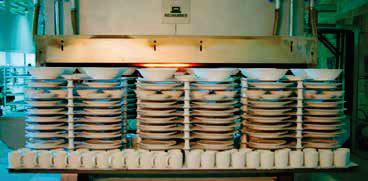
BCMEA says in the financial year 2023-24, one of Bangladesh’s leading tableware manufacturers, Star Porcelain, exported BDT907.2 million worth of porcelain tableware, holding the number one position in tableware exports. Shinepukur Ceramics was the second largest exporter with BDT813.8 million, followed by Paragon Ceramic Industries with BDT712.7 million, Artisan Ceramics with BDT650 million, Akij Ceramics with BDT568.9 million, and Protik Ceramics with BDT305.9 million.
In 2023-24, porcelain tableware manufacturer Akij Ceramics emerged as the largest stakeholder in total local and export sales with BDT2,630.4 million, which is 22.74% of total sales. It also became the biggest supplier to the domestic market with sales of BDT2,061.5 million.
Akij Ceramics officials say their success was due to their aesthetically appealing designs and high-quality products at competitive prices. Their dinner sets, tea sets, coffee sets, and rice bowls have become popular in both domestic and export markets.
Previously, before Akij’s full-scale startup in 2023, and Star Porcelain’s increase in exports that year, Shinepukur Ceramics was the largest manufacturer, exporter and domestic supplier for a quarter century.
Shinepukur Ceramics secured second position in total sales in 2023-24 and recorded a 16.02% share. Paragon Ceramic Industries performed third with 13.17%, while Protik Ceramics, Star Porcelain and Artisan Ceramics became the fourth, fifth and sixth largest with 12.95%, 11.84%, and 8.21%, respectively.
According to BCMEA, the export market tableware sales registered BDT5140.3 million in 2023-24. During the year, total sales on the domestic market totaled BDT7564.8 million.
In the global export market, Bangladesh’s export manufacturers, especially Shinepukur Ceramics, Star Porcelain, Paragon Ceramic, Artisan Ceramics, Monno Ceramic, Akij Ceramics, FARR Ceramics, and Protic Ceramics, have so far established a potential client portfolio, building up their corporate image as a leading porcelain and bone china tableware manufacturer and exporter from Bangladesh.
With a production capacity of two million pieces a month, Shinepukur represents Bangladesh tableware manufacturers’
Akij Ceramics Ltd (Trishal, Mymensingh)
Artisan Ceramics Limited (Bhabanipur, Gazipur)
Bengal Fine Ceramics Ltd (Bhagalpur, Savar, Dhaka)
Clay Image Ceramics (Mirpur, Dhaka)
FARR Ceramics Limited (Bhabanipur, Gazipur)
Jubok Ceramic Ind Ltd (Tejgaon, Dhaka)
Lauder Ceramic Materials Co Ltd (Aryhazar, Narayanganj)
Monno Bone China Ltd (Dhamrai, Dhaka)
Monno Ceramic Industries Ltd (Dhamrai, Dhaka)
Paragon Ceramic Industries Ltd PCIL (Mirzapur, Gazipur)
Peoples Ceramic Industries Ltd (Tongi, Gazipur)
Protik Ceramics Ltd (Dhamrai, Dhaka)
Protik Fine Ceramics Ltd (Dhamrai, Dhaka)
Shinepukur Ceramics Limited SCL (Kashimpur, Gazipur)
Standard Ceramic Industries Ltd (Joydebpur, Gazipur)
Star Porcelain Bangladesh Ltd (Madhabpur, Habiganj)
Tajma Ceramic Industry Ltd (Sherpur Road, Bogura)

typical image. Equipped with the most modern production plant and the latest machinery from Takasago, Mino and SKK of Japan, Shinepukur produces a variety of bone china and porcelain tableware for retail, hospitality industry, and houseware customers. It has more than 400 shapes. 233 for porcelain and 172 for bone china. Also, it has about 3,500 developed designs for porcelain and bone china.
Bangladesh’s ceramic industry sources say the lack of domestic supply of raw materials and anomaly in customs duty on imported raw materials are two of the major issues that restrict growth as an export manufacturer. Ceramic manufacturers allege that, in many cases, import-related duties do not match the real














































































charges to be levied because of the absence of an industryfriendly environment in customs clearances.
The tableware manufacturers believe that the present annual export earnings from ceramics, currently almost entirely porcelain and bone china tableware, will double to $100 million within a short time, if the setting up of raw material manufacturing facilities is supported with incentives and a favourable environment for growth in ceramic production, as well as if gas is supplied at prices that can help compete with rival countries.
Tableware manufacturers have urged the government to reduce gas prices and ensure an uninterrupted gas supply and also withdraw the supplementary duty (SD) on ceramic products to safeguard the industry. Manufacturers argue that subsidised and stable gas can help them effectively compete with other rival exporting countries rich in domestic raw materials.
“Bangladesh’s cheaper and high-quality indigenous natural gas can strategically help maintain balance in cost-effective production for exports,” suggests Moynul Islam, president of BCMEA and senior vice chairman of tableware manufacturer Monno Ceramic Ind Ltd.
Indigenous natural gas and plenty of cheap workers were a great boon to the ceramic industry development in hydrocarbonrich Bangladesh a few decades ago. The country has no significant local raw materials which are imported. However, it now suffers badly from a gas shortage, as there are fewer gas exploration and development activities. Gas supplies are supplemented by imported LNG.
To promote Bangladesh’s position in the ceramic world, BCMEA continues to hold its exposition successfully. It will hold its fourth biennial event Ceramic Expo Bangladesh 2025 on 27th-30th November 2025 (shifted from the previously announced date of 28th November-1st December 2024).
Steady economic expansion helps the Bangladesh ceramics industry to grow continuously. It is a lucrative hub for suppliers of raw materials, as well as plants, machinery and equipment.
The exposition caters largely to the benefit of the Bangladesh ceramic industry, as well as exhibitors of clays, stones, feldspars, minerals, glazes, frits, pigments, colours, chemicals and other ceramic raw materials from different countries, mainly from Asia Pacific and Europe.

Bangladesh’s ceramic tableware exports to the European Union countries. Unit: US Dollar thousand
Source: International Trade Centre (ITC), Geneva.
GruppoColorobbiacontinuestopushtheboundariesofceramicinnovationwithnewsolutions thatmatchdesignswithdigitalreliefsandtechnicalfinishes.
Meeting the growing market demand for customised ceramic surfaces with advanced technical and aesthetic properties, Gruppo Colorobbia has announced the expansion of its MicrotechCReadyandFORMAPlusranges.Thesenewsolutions are designed to enhance both the functional performance and the creative potential of ceramic surfaces, reinforcing the company’s ongoing commitment to innovation and quality.
The ceramic industry continues to evolve, with manufacturers and designers seeking materials that combine durability, texture, and design freedom. In response, Gruppo Colorobbia has developed new technologies aimed at improving surface performance and production efficiency across a wide range of applications.
Microtech CReady: Versatility and performance
The Microtech CReady microgrits, available in 40G, 70G and 90G grades, are engineered to perform across an extensive range of firing temperatures and are suitable for all wet application technologies currently used in the industry. Whether applied individually or in combination with glazes, these microgrits ensure outstanding results in both technical and aesthetic terms.
With low application weights, Microtech CReady optimises preparationstagesandoffersflexibilityinproductionbatches.The product enables manufacturers to achieve the perfect balance between gloss levels, texture, and functional performance. Key surface properties such as easy cleaning, abrasion resistance, and anti-slip capability can be finely adjusted according to project requirements, ensuring exceptional results in both residential and commercial settings.
FORMA Plus: Enhancing design and materiality
The FORMA Plus range further extends the company’s surface technology portfolio. This line includes water-based digital glazes (Extra-Glazes), hydro-repellent Graffiti inks, and the Neogrits collection of grits, each designed to boost materiality, colour depth, and tactile appeal. Recent additions to the range include the Graffiti White ink, which guarantees a precise opacity layer and optimal drying time for superior colour definition and application consistency. Also new are matte grits that allow the creation of reliefs and textures directly on the ceramic body and/or prior to digital decoration. These materials are fully compatible with any production line layout or format, enabling seamless integration into existing manufacturing processes.

When combined, Microtech CReady and FORMA Plus technologies unlock new possibilities for the creation of high-performance ceramic surfaces. This synergy enables manufacturers to achieve three-dimensional effects, enhanced functional properties, and unparalleled visual quality, delivering products that meet the highest design and durability standards.
All technical finishes within these ranges have been certified by independent laboratories, confirming their compliance with international quality benchmarks and ensuring consistent performance over time.
With these latest developments, Gruppo Colorobbia continues to strengthen its position as a leading innovator in ceramic materials and technology. The expansion of the Microtech CReady and FORMA Plus lines reflects the company’s dedication to continuous improvement, customer collaboration, and technological excellence.
Through a combination of research, design expertise, and practical know-how, Gruppo Colorobbia remains at the forefront of developing solutions that bring together aesthetics, performance, and production efficiency, shaping the future of ceramic surfaces worldwide.
Founded in Italy over a century ago, Gruppo Colorobbia is a global leader in the production of raw materials, colours and technologies for the ceramic, glass and coatings industries.


Feldspar has joined the list of critical minerals despite its abundance, with demand growing not only from ceramics but other applications like glass that will only increase pressure on supply, writes Rohan Gunasekera.
Feldspar is usually described as an abundant mineral, widely available. But growing demand from a wide range of applications and concentrated sources of supply mean it is being looked at as a critical raw material (CRM). Although feldspar may not have reached the same level of criticality as other minerals that are essential for key defence applications like making missiles and battle tanks, the fact that governments are moving to secure its supply shows its importance. Also, miners and manufacturers are aware that feldspar is a finite resource, like other minerals dug up from the ground, and that mines and deposits eventually get depleted.
Growing demand for feldspar is supported not only by an expanding ceramic industry, but also growth in other applications where it is needed such as glass and paints. That means ceramic users face competition for the raw material from other industries which will add pressure to supply. Explosive growth in demand for solar glass is a good example. Growing demand in traditional glass sectors such as containers, and window and automobile glass will boost demand for feldspar, with which ceramic manufacturers will have to compete. The ceramic industry remains the main user of feldspar, for now at least. But just like other raw materials used in ceramic manufacture
have seen demand emerge from new applications, feldspar too might be subject to similar demand pressures. The best example is lithium’s use in lithium-ion batteries for electric vehicles, which saw its price increase sharply and fluctuate. Lithium-ion batteries now account for the primary global end-use, followed by ceramics. Likewise, a new source of demand for feldspar could come from newly developed sodium-ion batteries that are just beginning to be introduced. Although it is still too early to draw conclusions, feldspar suppliers have begun talking about emerging demand for high-purity sodium feldspar in the new energy field
The trend towards thinner ceramic products, especially in products like tiles, demonstrates the usefulness of feldspar. Also, the trend towards larger sizes of slabs in tile manufacturing supports the use of more fluxes such as feldspar to improve firing performance. Manufacturers are looking for better quality, higher purity raw materials, which means better processing requirements and supply chain traceability. Asian raw material suppliers are upgrading their own processing systems to enable them to provide manufacturers with higher quality materials, the supply of which had previously been dominated by European multinationals.
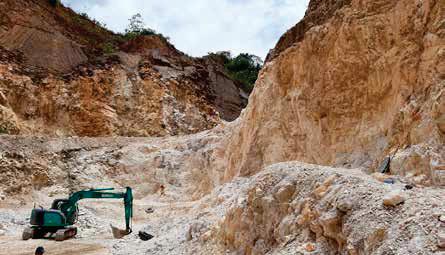
Feldspar is ground to about 20 mesh for glassmaking and to 200 mesh or finer for most ceramic and filler applications. In ceramic


manufacturing, feldspar is the second most important ingredient after clay. It is mainly used in tiles, sanitaryware and glazes. It is prized for its role as a flux in ceramic manufacture. Feldspars play an important role as melting agents in ceramic and glass applications. Fluxes lower the firing temperature or shorten the firing time which can reduce energy use and emissions. Feldspar also improves the ceramic body's strength, hardness, and durability. Despite feldspar being the most common mineral in the earth’s crust, the European Union (EU) included feldspar on its list of critical raw materials (CRMs) in its 2023 Critical Raw Materials Act, given concerns about its availability. The concept of ‘criticality’ does not necessarily mean these materials are considered scarce or have limited reserves. Rather, it reflects the risk of a supply restriction or disruption combined with a comparatively high economic importance.
According to a report on Critical Raw Materials and European Defence by the International Institute for Strategic Studies, the EU’s import reliance on feldspar is 54%. Most of the imports are from Turkey, the largest global producer of feldspar accounting for 32% of output. China and India are the other major feldspar producers. Advanced Western economies like the EU became dependent on imports as a result of economic and political choices. Mines and processing facilities, for instance, were closed as cheaper alternatives were sourced abroad and environmental concerns increased at home. The EU imports over 60% of its feldspar needs from Turkey, making the European market highly dependent on a single external supplier, according to an analysis by PricePedia.
as one of its ‘Major Minerals’, along with other minerals like mica and quartz, shifting them from the list of minor minerals. This move followed the approval of the National Critical Mineral Mission by the Union Cabinet on 29th January 2025. The Mission envisages exploration and mining of critical minerals within the country including recovery of these minerals from mines of other minerals, overburden and tailings.
Feldspar, quartz and mica are found in pegmatite rocks, which are an important source of many critical minerals such as lithium, niobium, molybdenum, tin and titanium. These minerals have a vital role in various new technologies, in the energy transition, spacecraft industries and the healthcare sector.
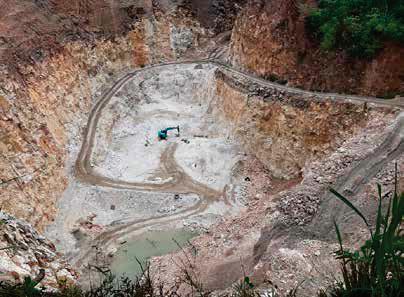
When leases of minerals like feldspar are granted as minor mineral leases, the lease holders do not declare the existence of critical minerals or extract critical minerals associated with them such as lithium, as their primary objective is to use these minerals as minor minerals for construction, and in glass and ceramic making. In consequence, the critical minerals associated with these minerals were neither extracted nor reported. While mining either mineral, associated minerals is inevitably produced. Given the importance of these minerals, the Indian government recommended their shifting from the list of minor minerals to the category of major minerals. Once categorised as major minerals, there would be an increase in exploration and scientific mining of these minerals which are an important source of many critical minerals.
From 2000 to 2023, Turkey has covered an increasing share of European feldspar supplies, exceeding 80% of total EU supplies starting from 2018. In 2023, Turkey's share dropped to 68%, in favour of EU member countries, which grew to 26%. Among EU suppliers, Italy stands out, producing about seven per cent of the total feldspar globally.
In February 2025, India’s Ministry of Mines classified feldspar
According to Sibelco, in its operation in Turkey, its total production has now reached over 1,000,000 tonnes. Due to excessive demand from Europe’s high quality ceramic producers, the flotation plant’s capacity has been expanded to 400,000 tonnes per year. Sibelco Turkey’s deposits possess large reserves of natural high purity sodium feldspar, with reserves and resources contained in the region of 36 million tonnes. Conventional open-pit mining takes place in five major pits that operate 12 months a year and yield premium grade feldspar with a minimum sodium content of 10%.
Henan Ankai New Materials Co. (LSAK Feldspar) says global sodium feldspar production is expected to reach about 45 million tonnes a year, an increase of about 3.5% year-on-year, mainly due to mine expansion in China and Turkey. It supplies 100 mesh and 200 mesh sodium feldspar for use in the ceramic industry. In 2024, the global supply of sodium feldspar was mainly concentrated in major production areas such as China, Turkey, India and Italy. According to the ‘Global Mineral Resources Reserve Assessment Report 2024’ released by the China Geological Survey, the world has adequate sodium feldspar reserves, with exploitable reserves expected to exceed one billion tonnes, of which China accounts for about 30%, placing it first in the world.
In China, the production of sodium feldspar in 2024 was about 14 million tonnes, accounting for 31% of global total production. According to the National Bureau of Statistics, in late September 2024, market price monitoring showed that the average price of sodium feldspar was stable at RMB 600-700 per tonne ($84-98) (1 USD = 7.14 Chinese Yuan), an increase of about five per cent over the same period in 2023. A major factor in this price fluctuation is the increase in mining costs and logistics costs.
As the world’s largest sodium feldspar consumer market, China’s demand mainly comes from the ceramics and glass manufacturing industries. According to the ‘2024-2029 China Sodium Feldspar Plant Industry Development Trend Analysis and Future Investment Research Report’, in 2024, China’s ceramic industry’s demand for sodium feldspar was about nine million tonnes, accounting for 65% of the total domestic demand. At the same time, with the rapid development of sodium-ion battery technology, the demand for high-purity sodium feldspar in the new energy field has increased significantly, and annual demand is expected to reach 500,000 tonnes, a year-on-year increase of 20%.
On the international market, Turkey and India have increased their export efforts with their low-cost advantages. In 2024, Turkey’s sodium feldspar exports were expected to reach eight million tonnes, mainly sold to Europe and the Middle East; while India’s exports were estimated at about five million tonnes, with their target markets including Southeast Asia and North America. However, due to a brief increase in international shipping costs in early 2024, the landed price of sodium feldspar in some regions once climbed to $80-90 per tonne, 10% higher than during the same period in 2023.
The ceramic and glass industries are still the main consumers of sodium feldspar, but the rise of new energy industries is reshaping the demand structure, says Henan Ankai New Materials Co.
According to estimates by market research institutions, in 2024, demand for sodium feldspar from sodium-ion battery-related industries accounted for three per cent of global total demand. This proportion is expected to increase to eight per cent by 2027, becoming an important variable on the supply side.
It was the availability of good raw materials that motivated Noritake to establish a tableware manufacturing plant in Sri Lanka in 1972 and in particular a feldspar mine less than 10 kilometres from the factory in Matale in the island's central hills. As a result, Noritake receives first grade feldspar for the manufacture of its tableware.
The mine is operated by Lanka Ceramic which says its ‘Special Grade Feldspar’, the highest grade, is used mainly in the production of fine tableware and porcelain products. The next quality, known as ‘First Grade Feldspar’, is mostly used by tile manufacturers. Lanka Ceramic has increased output after an automated feldspar sorting machine was installed recently at the mine. This enabled it to enhance minerals extraction levels thereby reducing waste and prolonging the mine’s lifespan.
INCLUDED FELDSPAR ON ITS LIST OF CRITICAL RAW
(CRMS) IN ITS 2023 CRITICAL RAW MATERIALS ACT, GIVEN CONCERNS ABOUT ITS

According to TC Tennakoon, senior director of Noritake Lanka Porcelain, in Noritake’s tableware body formulations, about 25% is made up of feldspar. “Our monthly feldspar consumption for body and glaze is 50 tonnes, in crushed and lump form,” he tells Asian Ceramics. “The crushed form particle size varies from 1 mm to 12 mm. We get lumps for glazes as we need superior quality. We make our own body and our own glaze by ourselves. We get lump forms for the glaze because we can observe if there are any impurities which we ourselves can remove before use.”
Tennakoon says plenty of reserves are available at the mine while the price has not increased much. Noritake buys feldspar in lump form for around 8,000 Sri Lankan rupees (USD 26) (1USD = Sri Lanka Rs302) a tonne now, compared with around Rs 5,000 five years ago.
According to a study on CRM in the global high-throughput ceramic industry, the sector is exposed to the risk of shortage or sudden price growth of raw materials, particularly CRMs. The production of inks, pigments, dyes and effects for ceramic decorations is mainly susceptible to supply risk, and similarly to that of frits, glazes and grinding media. End-users of these materials, especially tile manufacturers, are equally exposed to the risk, albeit indirectly. However, the direct use of CRMs in ceramic bodies occurs massively only in feldspar, in different percentages in wall and floor tiles, sanitaryware, and tableware. Other subsectors such as silicate refractories and insulators, clay bricks and roof tiles, and machinery components do not make use of or only make occasional use of certain CRMs. The mix of raw materials applicable in a typical batch preparation of sanitaryware includes 20–30% feldspar, 40–50% kaolin and clay, and 20–30% quartz
Feldspar is introduced in different amounts in the various ceramic batches: from a few per cent up to 60% and over, depending on the degree of vitrification required. The major applications in the ceramic industry are porcelain stoneware tiles and slabs (45-60% of the batch), vitreous china sanitaryware (18-32% of the batch) and in glazes (20-70% of the batch).
The quantity of flux required depends on the characteristics of finished product: porous, semi-vitrified or vitrified bodies, as well as engobes or glassy coatings. These features are related to the
sintered temperature. Vitrified bodies, like porcelain and vitreous china, are fired at high temperatures, around 1,300°C, and require a moderate amount of flux – about 15 - 30%, preferentially potassic. In order to get highly vitrified bodies at a relatively low temperature, of around 1,180-1,220°C, as in porcelain stoneware and fine stoneware, it is necessary to increase the flux percentage to 4565%, preferably with higher sodium content. Also, feldspathic raw materials are sometimes used in porous or red-firing bodies as well, despite the low firing temperature of around 1,050-1,150°C, at which a dual role is played: filler and to a minor extent fluxing.
The ceramic industry uses most feldspathic materials and feldspar substitutes – around 79%. Strong differences in price and demand exist between the types of feldspathic materials such as sodic, potassic and quartz-feldspathic.
Global demand for feldspar has been stable in the 2016-22 period although prices have risen about 60% during that time. A slight increase in demand and prices is anticipated in the 2023-30 period. According to PricePedia, after a long period of stable prices between 35 and 50 per tonne from 2000 to 2021, the prices of Turkish feldspar have increased rapidly, going over 70 a tonne in May 2024, an increase of about 76% compared to the 2000-2021 average. As of early 2025, prices have remained at historic highs.
According to the US Geological Survey (USGS), identified and undiscovered resources of feldspar are more than adequate to meet anticipated world demand. Quantitative data on feldspar resources existing in feldspathic sands, granites and pegmatites generally have not been compiled. “Ample geologic evidence indicates that the resources are large, although not always conveniently accessible to the principal centres of consumption,” USGS says.
In 2024, estimated US domestic production and sales of feldspar were unchanged, and the average unit value increased six per cent compared with 2023. Estimated imports of feldspar more than tripled, and imports of nepheline syenite increased seven per cent compared with those in 2023.
Other studies indicate that the feldspar supply may not be as abundant as believed, especially considering their chemical composition needed for different applications. The amount of feldspar extracted every year worldwide ranged from about 29 million tonnes in 2016 to about 32 million tonnes in 2022. Around 25 million tonnes are estimated to be destined for the ceramic industry annually.
Some studies highlight how intense ceramic production in Spain and Italy has led to severe repercussions on demand for raw materials, particularly sodic feldspar, mostly from Turkey. They warn that alleviating supply risk is urgently needed since reserves for sodic feldspar are limited and with no viable economic alternatives. Regarding feldspathic raw materials, more than 575 million tonnes have been globally mined since 1971, largely to produce ceramic and glass materials. They warn that regardless of feldspars being the main constituents of the Earth’s crust, the increasing demand should raise concerns given the ceramic industry market flux.
Studies have shown that a detailed analysis of ongoing trends in the ceramic tile industry, primarily driven by technological innovation, indicates possible criticalities in the medium-term supply of key raw materials, principally sodium feldspar from albitite source rocks. They say that the information available from distinct sources – including substitutes and secondary raw materials – is insufficient to draw a reliable picture of ceramic flux production and use. Such a picture is essential to foresee industrial needs and unveil possible criticalities for a secure supply of fluxes, beyond the general assumption that reserves are huge, simply because feldspars are
the most abundant minerals in the Earth’s crust. Account must be taken that industry demand is linked to the technological behaviour of feldspathic fluxes, which vary according to their source, composition and mineral processing.
These studies say that industrial flux use is changing depending on environmental sustainability needs and technological innovation. In recent years, the ceramic industry is increasingly demanding fluxes with high fusibility, which melt and soften and can be fused (united) with another material easily at lower temperatures. This is because they enable manufacturers to move towards sustainable manufacturing through double actions. One is to ensure a lower temperature and a shorter firing time to reduce energy consumption per unit of finished product. The other is to enable the use of other fluxes with low or very low fusibility, available locally or at a lower price, in order to improve resource efficiency.
Innovation's substantial role in varying the use of raw materials is exemplified by trends in Italy’s Sassuolo-Scandiano district, which has technological leadership in ceramic tiles. Within this sector, porcelain stoneware is continuously gaining market share, especially with the present traction towards ever larger sizes, reaching 120x240 cm up to 180x480 cm for each slab. The bodies used for such large slabs require a high amount of fluxes, preferably sodic, to improve the sintering process. This trend is inducing a growing demand for fluxes from albitites that influences the international market, since all the other ceramic tile districts are starting to manufacture porcelain stoneware large slabs.


In the ceramic industry, where technological innovation must constantly balance performance, flexibility, and sustainability, System Ceramics, part of the Coesia Group, has redefined the standards of digital decoration with the launch of Infinity Sky.
Following its debut as a concept at Tecna 2024, System Ceramics’ Infinity Sky technological platform is now available as a fully developed product. It features a refreshed aesthetic, upgraded electronics and, most importantly, a distinctive innovation: a printhead self-cleaning system
The challenges of today’s ceramic market
The ceramic sector is highly dynamic. Factors such as customisation, functionality and aesthetics are now key competitive drivers. Manufacturers demand technologies capable of offering flexible configurations for different designs, minimising machine downtime, maintaining high-quality standards, and meeting increasingly essentialsustainabilitycriteria.
The evolution from the 2024 prototype to the final version of Infinity Sky was driven precisely to meet these demands. It represents not just a technological upgrade but a genuine revolution in the approach to digital ceramic decoration. The system brings together all the functionalities requested by the market into a single solution, capable of adapting to any production scenario without compromising on quality or operational efficiency – providing what System Ceramics calls ‘the best tailored solution’.
Uncompromising configurability: up to 16 bars on a single machine
The technological core of Infinity Sky lies in its architecture, now available in four models with four, eight, 12 or 16 independent bars. This means that up to 16 bars can be operated simultaneously on the same machine, opening up previously unimaginable creative possibilities.
The most distinctive characteristic is that each bar can be configured independently and equipped with different types of printheads. This approach enables the creation of complex graphic effects, sophisticated layering, subtle shading and precise textures without modifying the machine’s structure. The result is production versatility that turns every job into an opportunity for aesthetic differentiation, offering tangible benefits for manufacturers.
Exclusive technologies within the System Ceramics ecosystem
One of the most significant aspects of Infinity Sky is that it integrates multiple proprietary technologies that work together to ensure superior long-term performance:
·Ink recirculation reversal system: prevents ink sedimentation bymaintainingconstantcirculation,evenduringlongstoppages, ensuring uniform print quality over the machine’s lifecycle.
·Ultrasoundgeneration:leveragingthepropertiesofpiezoelectric printheads, this system guarantees prolonged and stable print performance, extending printhead life and significantly reducing replacement frequency.
These two systems work in synergy to give Infinity Sky its main competitive advantage: long-term reliability and consistent quality.
Intelligent printhead self-maintenance: a step change
The real innovation of Infinity Sky lies in its intelligent printhead self-maintenance system. Each bar is equipped with a pneumatic lifting mechanism that automatically activates during pauses, isolatingthebarfromthesubstrateandpreventinginksedimentation on inactive units while the others continue to operate.
Additional features include:
·Automatic mixing system: keeps ink in the tanks uniform and usable, even after long periods of inactivity.
·Active protection system: minimises wear through automated protocols that preserve optimal functionality.
·Intelligent management logic: keeps even temporarily unused heads operational, maintaining ink circulation and component integrity.
Sustainability: System Ceramics’ integrated approach
Today, sustainability means much more than compliance with environmental regulations. In a modern business context, it is a strategic imperative that shapes an overall business vision, incorporating circular economy principles to achieve ever more efficient production.
In the ceramics sector, true sustainability goes beyond emissions and direct environmental impact, focusing on machine efficiency, waste minimisation and resource optimisation over the entire operating lifecycle.
Infinity Sky fully embraces this broader concept of sustainability with clear and concrete priorities:
·Operational durability: self-maintenance functions significantly extend printhead lifetime, drastically reducing the need for frequent component replacements and increasing the system longevity.
·Optimised ink management: integrated advanced controls reduce material waste and ensure consistent print quality.
·Reduction in waste: the system’s precision and operational stability minimize defective production, lowering overall environmental impact.
·Support for water-based inks: a key factor in reducing
ONE OF THE MOST SIGNIFICANT ASPECTS OF INFINITY SKY IS THAT IT INTEGRATES MULTIPLE PROPRIETARY TECHNOLOGIES THAT WORK

VOC emissions and complying with modern environmental standards, positioning Infinity Sky within System Ceramics’ wider technology ecosystem.
Infinity Sky: a strategic new element in the System Ceramics ecosystem
Infinity Sky is not an isolated development but part of System Ceramics’ broader technological vision. Launched alongside Infinity Dry at the 2025 IN-TOUCH Open House, it highlights the company’s strategic focus on decoration as a key stage in defining product aesthetics and competitive differentiation.
Together, the wet and dry digital solutions demonstrate a comprehensive approach to ceramic surface treatment, where adaptability and precision form the foundation of a futurefocused portfolio.
Digital ceramic decoration: looking ahead
As digital technology increasingly narrows the differences between solutions, the experience and know-how of a leading company such as System Ceramics can make all the difference. Infinity Sky shows how a deep understanding of market dynamics can translate into technological developments that meet manufacturers’ operational needs.
This machine is more than a technological upgrade – it exemplifies that innovation comes from listening to the market and transforming customer needs into advanced solutions. With Infinity Sky, System Ceramics consolidates its role as a strategic partner for all manufacturers who are investing in reliable, scalable and futureoriented solutions.
The introduction of this technology marks the beginning of a new era in digital ceramic decoration, where creativity, efficiency and sustainability are no longer competing goals but complementary elementsofanintegratedvisionforthefutureoftheceramicindustry.

Witha population of nearly 70 million, Karnataka stands as the second most populous state in southern India and one of the fastest-growing markets in the country. Known for its thriving urban centres, expanding infrastructure projects, and rising real estate demand, Karnataka has emerged as the largest consumer of ceramic tiles and sanitaryware products in the southern region.
The state of Karnataka is one of the largest consumers of ceramic products in India. The vibrant construction sector in Karnataka has fueled the demand for ceramic tiles, sanitaryware and heavy clay products in the state. The state's strong economy is driven by information technology (IT), biotechnology and aerospace industries located in and around Bengaluru, Karnataka’s capital city. A number of large and organised producers have established a strong presence in the state through distributors, exclusive showrooms, and large warehouses.
Somany Ceramics, a leader in the tile industry, has launched six new showrooms across Bengaluru, Tumkur, and Mysuru Spanning a total area of over 16,000 square feet, this strategic expansion under the ‘Karnataka Rising’ initiative aims to conquer significant market share in one of the largest ceramic tiles and sanitaryware consumption states in India.
In a media statement, Amit Sahai, CEO, Somany Ceramics, says: “Karnataka remains a key market for us, and this expansion

reinforces our commitment to premium surfaces. With six new showrooms launched in March and three in February in Bengaluru, Tumkur, and Mysuru, we are strengthening our retail presence across the state.”
Despitethestate'senormouspotential,ceramicproductionhasnot flourished. Availability of reasonably priced tiles and sanitaryware products from Gujarat has discouraged ceramic producers and investors from setting up production facilities for ceramic tiles and sanitaryware.
India’s southern region and states are big consumers of ceramic tiles and sanitaryware comprising about 25-30% of the ceramic tile market, despite a share of about 18% of the country’s population. However, despite the huge consumption, there are no big-sized ceramic producers in the region. Karnataka, however, is well suited to the establishment of a ceramic manufacturing cluster. There is tremendous potential for establishing a ceramic cluster in Karnataka due to its geographical proximity to all states in the region, good infrastructure, and abundance of resources, including ball clay, talc, and other clays from Andhra Pradesh's Dwarka Tirumala region, and feldspar and quartz deposits in the
Leading ceramic products manufacturers in Karnataka

Nellore and Gudur regions.
With a number of ports in close proximity, establishing a new manufacturing hub in the South would dramatically reduce logistical costs. A square metre of tiles procured from Gujarat is approximately INR 50-60 per square metre for transportation to southern states. However, the transportation cost from the state to other states in the region would be a fraction of the cost. This will translate into a massive reduction in costs for the dealers and end consumers.
India’s second largest ceramic tile producer, H & R Johnson operates a production plant at Kunigal in the state. The company which has been operating in the ceramic manufacturing space since 1958 is among the most reputed ceramic tile producers in the country.
With an installed capacity of more than 64 million square metres per annum, the company achieved sales of 57.7 million square metres of ceramic tiles in the 2024-25 financial year

A number of large and organised producers have established a strong presence in the state through distributors, exclusive showrooms, and large warehouses.
Wienerberger is the largest global producer of hollow clay bricks. Operating in India for more than one and a half decades, Wienerberger India has emerged as one of the most important producers of hollow bricks in the country.
Wienerberger India’s production plant is located in Kunigal in the state. Its production facility is a fully automated, state-of-the-art facility that manufactures Porotherm smart bricks for the Indian market. Spread across 30 acres, production at this facility began in 2009; being a first of a kind fully automated, environmentfriendly production unit for manufacturing of clay hollow bricks in India. The company’s flagship product, Porotherm Smart Bricks, has demonstrated exceptional environmental performance in Life Cycle Analysis (LCA) studies conducted by LEAD Consultancy and Engineering Services (India) Pvt Ltd.
From the subtle elegance of matte nishes to the expressive depth of digital reliefs, Cersaie 2025 captured ceramics’ journey – from beauty to purpose, from trend to sustainability, and from innovation to responsibility, says Dinesh Vyas, a technomarketing specialist with extensive experience at industry leaders such as Ambuja Cement, Larsen & Toubro and Prism Johnson.
The42ndeditionofCersaie,theworld’sleadingexhibitionforceramic tiles and bathroom furnishings, concluded on 26th September 2025 at BolognaFiere, Italy. It reaffirmed its role as the global hub for design, technology and sustainability in the world of ceramic tiles.
With close to 600 exhibitors from over 25 countries and thousands of tile manufacturers, designers and professionals attending, the five-day event reflected a maturing industry –moving from visual novelty towards efficiency, performance and purpose
The global stage
Cersaie 2025 brought together tile manufacturers, material suppliers, designers and distributors shaping the future of ceramics.
Italy’s mastery in design and presentation remained impressive, while Spain, Turkey and India demonstrated evolving design maturity. Participation from the Middle East, Africa and Latin America highlighted how global and interconnected the ceramic world has become.
For tile manufacturers, the halls dedicated to inks, glazes, and raw materials drew strong attention – reminding visitors that true innovation often begins not with surface design, but with material science. These innovators from Italy and Spain have also helped tile manufacturers in India and elsewhere to scale up to global design standards.
Two pillars of progress: Technology and sustainability
If one idea united every exhibition hall, it was sustainability. It is no longer a slogan – it is now a necessity. Together, these twin forces – sustainability and digitalisation – define the modern ceramic ecosystem.
Tile makers and raw-material suppliers alike placed eco-friendliness at the heart of their communication: recycling waste at every stage of production, adopting closed-loop water systems, low-VOC inks and deploying energy-efficient kilns.
At the same time, digital transformation has moved beyond printing to embrace high tech and even AI-driven design tools, real-time defect detection and data-based firing control –improving quality while reducing waste.
Efficiency, traceability and precision now hold as much value as aesthetic design.

Design language: Tactile minimalism to bold expression
Cersaie 2025 revealed how surface design can be both subtle and expressive, thanks to modern digital decoration technologies that allow precise control over texture and depth.
On one hand, the fair celebrated tactile minimalism – soft mattes, fine micro-reliefs and muted earthy tones – brought a sense of calm sophistication. These surfaces invite touch and align beautifully with today’s wellness-driven interiors and the global trend of quiet luxury.
On the other, expressive digital reliefs made a striking appearance. Advances in digital glaze layering have produced high-relief textures, fluted geometries and sculptural 3D effects. These tiles add depth and drama, creating bold possibilities for feature walls, facades and boutique spaces.
Together, these directions demonstrate how technology today enables both serenity and statement. Whether subtle or dramatic, surface tactility has become the new design language.
Material science meets digital synergy
The unique surfaces presented showed the quiet power of ink and glaze innovation.
Leading suppliers such as Torrecid, Videres, Colorobbia and Vidres displayed eco-friendly water-based inks, special glazes, granules and energy-saving frits that deliver rich textures with a reduced environmental footprint. These advances merge creativity with conscience – an evolution especially relevant for Indian manufacturers upgrading to the next level of digital precision.
Conversations beyond products
Having visited Cersaie after several years (my last visit was in 2018), it was interesting to observe how the event has evolved into much more than a product fair.
With extensive online coverage and digital participation, Cersaie now reaches a far wider audience – cementing its status as a global learning platform for everyone connected to the ceramics and surface materials industry.
Industry insight: From appearance to lasting value I noted two key shifts at Cersaie 2025 – each signalling a positive evolution for the global industry.
1. Sustainability took the spotlight
This year, sustainability was not a supporting theme – it was the central story. Every major manufacturer and supplier built their message around environmental stewardship.
2. From aesthetics to performance
Marketing has matured – from focusing on how products look to how they perform. Durability, hygiene, slip resistance, energy efficiency and carbon impact now form the core of product communication.
The Building, Dwelling, Thinking conference series once again brought together architects and design leaders to explore ceramics’ expanding role in sustainable and humancentric spaces.
Tiles are, of course, a vital part of a designed environment, but the final ambience depends on how architects or interior designers integrate multiple materials. Tile makers should therefore focus on supportive, versatile aesthetics and technical excellence – creating surfaces that look beautiful, perform reliably and endure over time.
Global insights for local learnings
India is now the second-largest tile producer, with more than a thousand factories and a highly diverse and dynamic market. The affordable segment reflects strong regional preferences in colour and finish, while the premium segment is increasingly global due to the involvement of designers with international exposure. From Cersaie 2025, Indian brands can draw several key lessons:
1. Follow global aesthetics wisely
Matte and textured earthy tones dominate global preferences. However, deep fluted or high-relief surfaces may pose maintenance challenges in India’s dusty environment and are best suited for niche projects.
2. Large formats – show less, show better
Leading suppliers such as Torrecid, Videres, Colorobbia and Vidres displayed ecofriendly water-based inks, special glazes, granules and energy-saving frits that deliver rich textures with a reduced environmental footprint.
The Indian industry has embraced large slabs, but showroom display remains a challenge. Dealer-run outlets often over-display, diluting the experience. The focus should shift from showing more to curating better.
3. Mock-ups and storytelling matter
Every successful booth at Cersaie told a coherent story. Indian showrooms need the same approach – helping customers visualise complete spaces rather than isolated samples.
4. Marketing with depth
Globally, the narrative now emphasises performance and sustainability. Indian brands should communicate around functionality and endurance, not just visual novelty.
5. Adopt innovation thoughtfully
Many innovations at Cersaie are experimental. Manufacturers must evaluate their local suitability – balancing creativity with cost, climate and market needs.
6. Installation: The real challenge
The popular Tiling Town segment focused on the craft of installation, especially for large-format tile applications, reinforcing that design innovation succeeds when matched by skill on site. In India,thisremainsmajorgapthatrequiresurgentattentionasboth large projects and individual homeowners face challenges with large size porcelain tile installations.
India’s next leap will come not from producing more tiles but from producing smarter, cleaner and better-presented tiles, supported by perfect installation practices.
Looking forward
Cersaie 2025 showcased an industry evolving beyond surface beauty towards responsible innovation and long-term value. The conversation is shifting from ‘How it looks’ to ‘How its made and how will it perform’.
I can say with a fair degree of confidence that the future of ceramic tiles belongs to those who combine design sensitivity, technical depth and creativity with conscience – and who address the real pain point: installation quality.
It’s ultimately a story about how we make products, how we live and how responsibly we choose to create our spaces.
It will be interesting to see how much of this thought-provoking vision from Cersaie 2025 translates into real-world action and implementation.

Geberit, a Swiss multinational founded in 1874 and headquartered in Rapperswil-Jona, is a European leader in sanitary systems and piping technology with global operations. In India, it operates as Geberit Plumbing Technology India Private Limited. In an exclusive interview with Asian Ceramics, Gorika Shyam, recently appointed managing director, Geberit India discusses her experience leading India sales at the company and shares insights into the challenges and opportunities shaping the organisation’s growth in the region.
Congratulations on your appointment as Managing Director at Geberit India. How does it feel after 15 years with the company?
GS: It feels both humbling and exciting. My 15 years at Geberit India have been deeply rewarding – starting with building a strong sales foundation, then expanding into partnerships with architects, developers and contractors. Each phase brought new learnings, from understanding the market pulse to building a resilient sales team..
How would you describe your leadership style? What makes a great manager?

Gorika Shyam, managing director, Geberit India
GS: I would describe my leadership style as peoplefirst leadership. For me, leadership is not about exercising authority, but about empowering teams to take ownership of their work and decisions. The best strategies are rarely written behind closed doors – they emerge when leaders truly listen and give their people a platform to shape ideas together. Growing up in an army household instilled in me certain nonnegotiables: focus, clarity under pressure, and the discipline of preparation. These qualities are central to my leadership DNA. I also expect them from my team – respect for deadlines, adaptability, accountability, and above all, a relentless focus on the task at hand.
To me, a great manager is one who listens deeply, empowers decision-making and nurtures a culture of ownership. Flattening hierarchies is vital; managers at every level should be able to
2025 HAS BEEN POSITIVE SO FAR, WITH STEADY GROWTH ACROSS PROJECTS AND RETAIL.

run their operations with an entrepreneurial mindset. The most effective leaders listen more than they speak, step back to create space for ideas and provide the support needed for their people to succeed.
In my experience, the leaders who leave the greatest impact are thosewholeadwithapurposethatextendsbeyondjustmaximising business performance. They take time to listen patiently, engage with details before approving decisions and, most importantly, invest in people – spotting potential and nurturing it consistently through mentorship.
What differentiates Geberit’s ceramic and sanitary systems in India’s premium market?
GS: Our true differentiator is Mastering the Flow of Water. With over
150 years of Swiss engineering, we design systems where every component – from cistern to ceramic to drainage – works in perfect coordination. This ensures water-efficient yet powerful flushing, ease of operation and maintenance, and long-lasting performance.
This mastery, combined with our Design Meets Function (DMF) philosophy, positions us uniquely in India’s premium segment. We are not just offering ceramics, concealed cisterns or HDPE drainage solutions; we are delivering complete systems that guarantee reliability, efficiency and elegance in every bathroom.
How is Geberit approaching retail growth in India?
GS: Geberit follows a structured approach across India, working closely with our existing partners in Tier 1 and Tier 2 cities while actively expanding our presence in Tier 3 markets. Our strategy is anchored in the design meets function (DMF) positioning, which combines premium design with proven functionality.
We set ourselves apart through uncompromising quality – Swiss engineering that guarantees long-lasting performance; exceptional service – strong after-sales support that builds trust with dealers and customers; and a consistent brand experience – from product displays to technical training, we empower our partners to deliver the Geberit promise at every touchpoint.
This approach enables us to strengthen our market reach, deepen relationships with our dealer network, and ensure customers across India experience the style, innovation and reliability that define Geberit.
What is your long-term vision for Geberit in India?
GS: IndiaisastrategicgrowthmarketforGeberit.Ourlong-termvision is to lead the sanitary industry transformation from traditional productbased selling to a system-based specification approach. This shift will span the residential, commercial and infrastructure segments.
Looking at 2025, what is the outlook for Geberit India?
GS: 2025 has been positive so far, with steady growth across projects and retail. Sanitaryware, in particular, is gaining momentum, supported by our strong behind-the-wall solutions. For the rest of the year, we will continue deepening our dealer network and accelerating sanitaryware penetration.
The Indian market is ready for a shift — and we are here to lead it. By staying true to our purpose of Mastering the Flow of Water, Geberit will continue to deliver value, trust, and innovation for years to come. ontinue to deliver value, trust, and innovation for years to come.









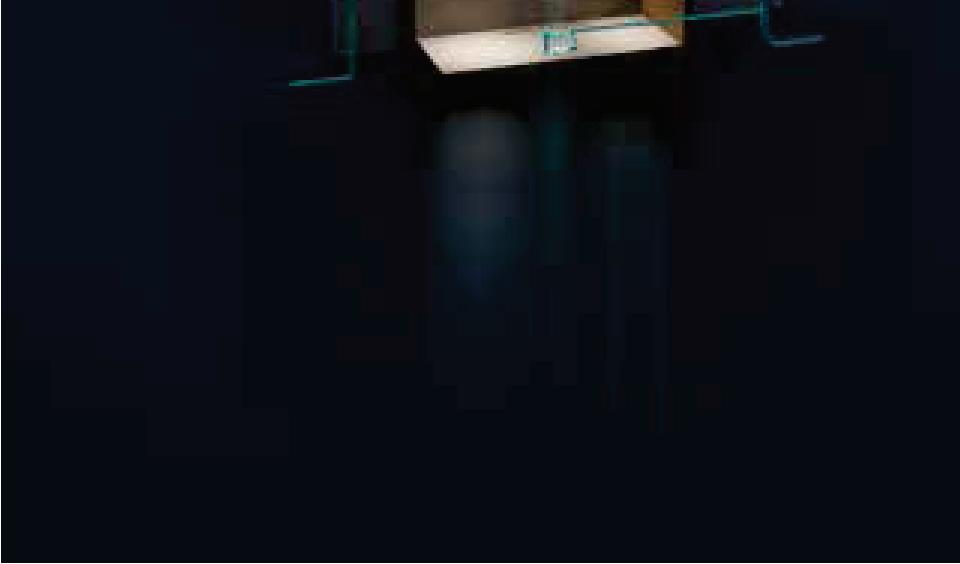



From also-ran to industry leader, Gujarat is now firmly in the frontline. However, Andy Skillen, special correspondent, Asian Ceramics looks at whether the spotlight might just be burning a little too bright for the region…
The success of Gujarat’s ceramic industry is a true rags to riches story. Back in 2005, this magazine spent weeks touring Morbi, Himatnagar and Thangadh to bring what was then an almost unknown ceramic manufacturing sector to the world’s attention. The sheer volume of factories that had quietly gone about their business supplying tiles, toilets and tableware to the low-mid-range domestic market was nothing short of remarkable: India had its very own version of Foshan or Sassuolo, and yet no one was paying it any attention.
Back then, things were a little different. Children carried boxes of tiles around factories, waste disposal was, at best, ‘sketchy’ and, most companies operated multiple sites to avoid crossing a tax threshold. Gujarat was indeed a ‘wild west’ for ceramic manufacture, carrying multiple risks for would-be investors, but rewarding the courageous and forward thinkers with the chance to be ‘in at the start’ of a major industry revolution.
Within two years, we founded the Indian Ceramics exhibition, which grew from strength to strength over the following five annual outings as suppliers and sourcers suddenly realised the untapped potential of this expanding ceramic powerhouse. The exhibition lives on despite being acquired by Messe Muenchen in 2014, and, sadly for the brand, being renamed ‘Indian Ceramics Asia’ to please its Chinese sales partner.
Things have, of course, have changed dramatically since those early years. Gujarat is now a major player in the international ceramic industry (accounting for about 8-9% of global output) and has assumed a degree of national importance that has both helped (and hindered) it. Far from now being ‘under the radar’, it now sits under a global spotlight and is a major contributor to export revenues for the sub-continent. There are somewhere between 800 and 1,000 factories operating in this land of entrepreneurship now (with the predictable problems of overcapacity) and the standards have risen inexorably.
‘Made in Morbi’ is now a brand to be proud of and not embarrassed by. Estimates will vary considerably, but Asian Ceramics’ opinion is that approximately 425,000 people are now employed directly by the industry, and the knowledge base that resulted from that means that product innovation and quality continue to improve annually. In the last 10 years, for example, ink-jet printing has taken off and there are now more than 200 units installed in tile factories across Gujarat, making it possible to produce tiles that are internationally competitive. They are often used in the production of largeformat slabs (1.2 x 3.6 metres) and are backed by energyefficient roller kilns featuring both waste-heat recovery and artificial intelligence (AI)-driven control systems that help cut




carbon emissions by 20%. Gujarat has certainly come of age. It is not just the tile sector that has upped its game of course. Sanitaryware leaders likeVarmoraandSenistonow deploy low-energy tunnel kilns, while high-pressure casting and slurry-recycling systems have helped reduce water consumption by 30%. Around 25% of production is now powered by solar energy, with TheIndian Council of Ceramic Tiles and Sanitaryware (ICCTAS)targeting 50% renewable usage by 2027. Compliance with theNational Clean Air Programme (NCAP) also mandates a 40% drop in particulate emissions by the end of this year. Clean and green? It’s certainly getting there, and this is improving market perception of Gujarat’s ceramic industry as a result. Overseas, this can be critical and of course becomes a major marketing point.
Logistics have also been a key consideration. Gone are the days on poorly packed trucks rumbling across damaged roads The supply chain has improved dramatically. When you look at companies such as Commander Vitrified Pvt Ltd, you can see how scale has transformed operations – the company now ships around 400 full container loads every month. Largeformat producers likeKajaria Ceramics(43.5 million sq.metres/ annum) andRAK Ceramics(118 million sq.metres/annum) also underline Morbi’s capacity to cater to global demand.
Quality raw materials are now sourced from Rajasthan and overseas. Gas supplies, though occasionally inconsistent, are subsidised, and proximity to major upgraded ports such as Mundra, Kandla and Pipavav is a significant advantage. These ports have become key gateways in Gujarat’s overseas ceramic penetration, with Mundra Port remaining the preferred option thanks to its mature ecosystem of Custom House Agents and third-party logistics handlers.
With its strategic location near both Mundra and Kandla ports, Morbi benefits from 20-25% lower logistics costs.
Approximately 1,500 containers leave the region daily. Coastal shipping has improved market reach to the middle-class, consumer-hungry booming states of South India, while theDedicated Freight Corridor (DFC), operational since 2023, has reduced rail transit times by 40%.
For overseas shipment, exports to the Middle East now takes seven to 10 days, while Europe-bound deliveries require 18-22 days. It’s not all been plain sailing (no pun intended) as global freight volatility has impacted operational costs and forced up shipping rates by 15% since 2022 whilst, around 30% of shipments have faced delays in the last 18 months. Nevertheless, given ceramics’ importance to the national





economy, such issues immediate government attention. To that end, theGujarat Maritime Boardhas committed 500 crore rupees for port upgrades by 2026, and a proposedCeramic Export Facilitation Centreis expected to reduce customs clearance time by 20%.




Such developments are timely, as pressure continues to build. By 2027, Morbi aims to double its ceramic output and reach a turnover of 80,000 crore rupees - almost all of which will need to be exported. The proposedMorbi Ceramic Park, featuring captive power plants, a dry port and single-window clearances, will doubtless be a major driver in achieving this. Government-backed schemes such asPM Gati Shaktiand thePLI Scheme(targeting 2,000 crore rupees in investments in 2026) are expected to boost innovation in smart sanitaryware and large-format vitrified tiles. Increased adoption of digital trade platforms, blockchain-based tracking and green energy are also set to enhance transparency, efficiency and competitiveness.
According to ICCTAS chairmanRishi Kajaria, India’s global market share in ceramics could rise from eight per cent to 12% by 2030 as global supply chains shift away from China. Pipe dream or reality? We will wait and see.
Export success has been a major area focus. In 2024, players in Gujarat generated around 20,000 crore rupees in export revenue, out of a total of 39,000 crore rupees of ceramic production in the state. Of these exports, porcelain tiles comprised 72% of volumes, growing 48% year on year. Sanitaryware exports have also grown significantly, reaching around 3,375 crore rupees (70% up since 2020).
In terms of destination, the USA accounts for around 65% of tile exports, with Saudi Arabia and the UAE following behind, whilst sanitaryware is penetrating both European and North American markets in greater volumes than before.




But…

‘Made in Morbi’ is now a brand to be proud of and not embarrassed by.


So, all in all, you might think now is a great time to be focusing on Gujarat. However, in the ying and yang of ceramic manufacture, the problem with all the positive attention the sector attracts is that there has to be a balance of negativity. The high profile that helps Gujarat’s ceramic makers on the international stage can also be a hindrance. Duties across the Gulf States have been forthcoming for Indian ceramic exports, to the point where a number of companies are now considering setting up operations there to avoid the problem, whilst the EU’s Carbon Border Adjustment Mechanism (CBAM), (see box) which is set to begin in 2026, could impact some 2,500 crore rupees of exports that are unable to meet the criteria being imposed.


However, the single largest elephant in the room at present is the tariff situation with the USA. With some two thirds of ceramic exports heading from India to Trump-ton, the risk of 50% tariff imposition and maintenance is potentially crippling. Indeed, some conjecture that it could change the face of India’s ceramic industry forever. If Indian tiles are forced from the market, then the likes of Mexico (where many US companies have operations), Spain and Italy will likely fill the gap, and it is difficult to see how this market share would be regained in the short-medium term. With tile imports up to nearly 40m. sq metres into the USA from India in 2023-24, this is going to create a lot of extra capacity for the domestic market instead. The result is that GST will come under pressure in India, as makers look to offload their product locally instead. Cutting this from 18% to 12% would be a target, reducing revenues for the central government as a result, but at least having the effect of maintaining the industry’s scale and preventing closures.
At present, it doesn’t look great. India's exports to the USA dropped by 20% in September alone, and nearly 40% in the last four months, as tariffs took effect.
September was the first full month of Washington's 50% tariffs on Indian goods, which kicked in on 27th August. This includes a 25% penalty for Delhi's refusal to stop buying oil from Russia. Overall shipments to the USA have seen four consecutive months of decline and are down from $8.8billion in May to $5.5billion in September.
There is hope. The recent meeting of Donald Trump and Narendra Modi did focus on speeding up a bilateral deal, which would reduce the tariffs again to a more manageable 16-18% perhaps for ceramics (still ahead of what other exporters to the USA would be paying, but an improvement), but these discussions take time.
And time is something that Morbi’s manufacturers, heavily invested in and running on relatively thin margins, simply don’t have.
Pressure is already on to replicate the success of the Morbi cluster elsewhere in India at a time when the former has had its head-turned on to the overseas market. Indeed, many now ask that with Morbi making 90% of all ceramics produced in India, the time has come to pose the question of whether one ‘Morbi’ is enough for an aggressively developing India?
Since 2022, remarkable growth, particularly in Tier II and III cities, has been a major driver of Indian construction and ceramics consumption. The ongoing trend of urbanisation expects a 50% rate in India by 2050, focusing on the potential of Tier II towns as the next real estate hubs. To accommodate the growing urban population, estimates suggest urban cities in India will require 230 million housing units by 2047. To that end, others want ‘in’. Consequently, within the next couple of years at the latest, a new ceramic cluster is targeted to be created in the south of India with Andhra Pradesh in pole position.
The availability of raw materials such as ball clay, talc, and other clays in the Dwarka Tirumala region, feldspar and quartz deposits in Nellore/Gudur region and underexploited natural gas reserves in the KG basin highlights the tremendous potential for a ceramic cluster in this state. In addition, as Chennai and Vizag ports are in close proximity, a new manufacturing hub in the South would drastically bring
down logistical costs. The southern states have been a big consumer of ceramic tiles and the biggest in India comprising about 25-30% of the ceramic tile market. The cost of shipping tiles from Gujarat to Telangana, is approximately three to four times what it would be if made locally. If momentum can be found, manufacturers are willing to get involved and there is a government will to support it, then this secondary hub could thrive. But therein lies the rub.
Will Gujarat stand by and allow its pre-eminent position to be eroded? Will it, in fact, have a choice? When you’re at the top, you will always be aimed at, and now Morbi, after so many years of being the underdog, is feeling the pressure of international fame. The question is, can it handle it?

Starting in 2026, goods entering the European Union will face a carbon price based on production emissions. When such items are imported into the EU, companies must account for carbon released during production. If these goods come from countries without similar carbon pricing systems, exporters will pay the difference between what was paid at the source and the current EU carbon price. The UK will follow suit with its own CBAM from 2027.
The mechanism follows EU’s ETS, which is important for knowing which goods are taxed. Some industries, despite indirect emissions from electricity use, are only taxed on direct emissions – those from burning fossil fuels. This aligns with how local EU industry is treated under the ETS, whereas others are taxed on both direct and indirect emissions. Ceramics will likely fall under the latter.
The financial stakes are high and companies importing these goods could see product prices increase by up to 40% by 2026 once CBAM is fully implemented.











































































































































